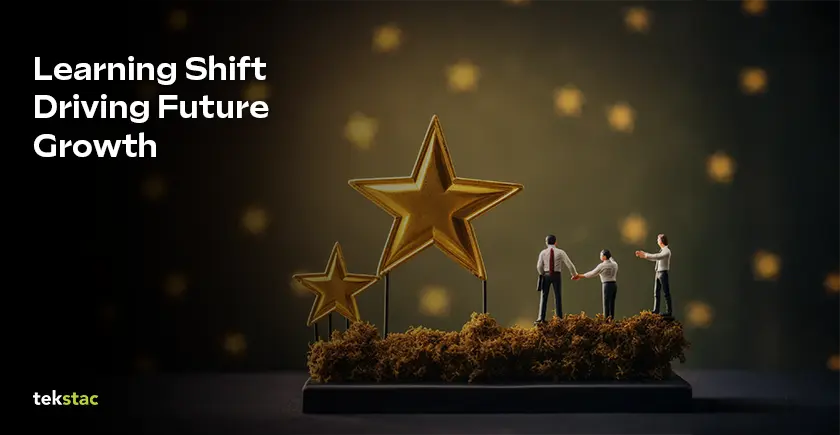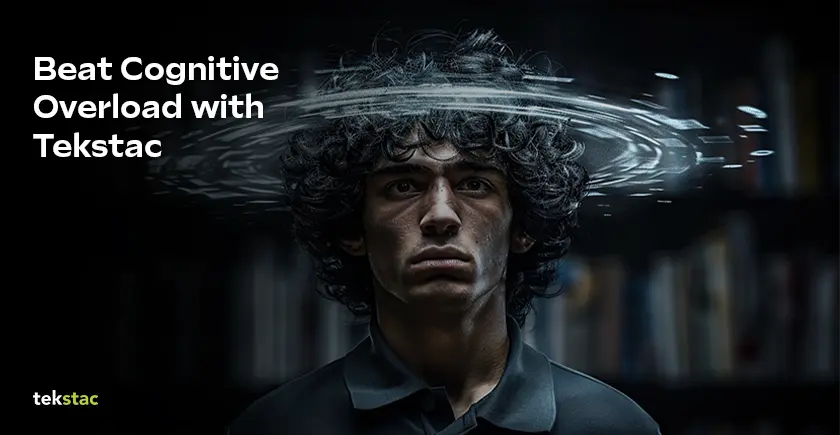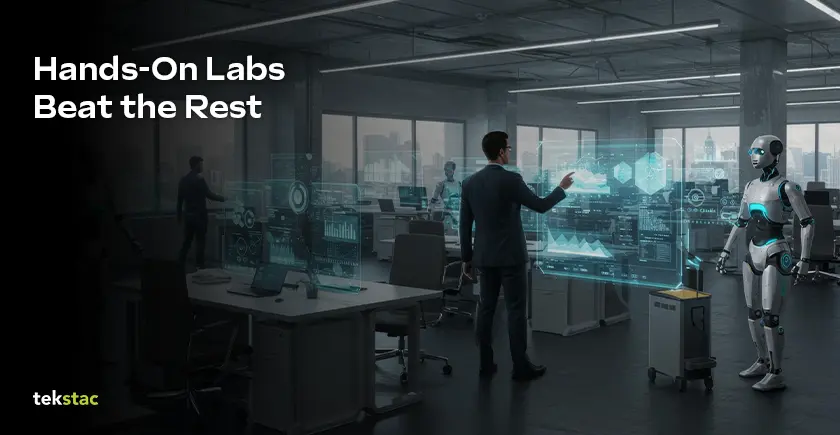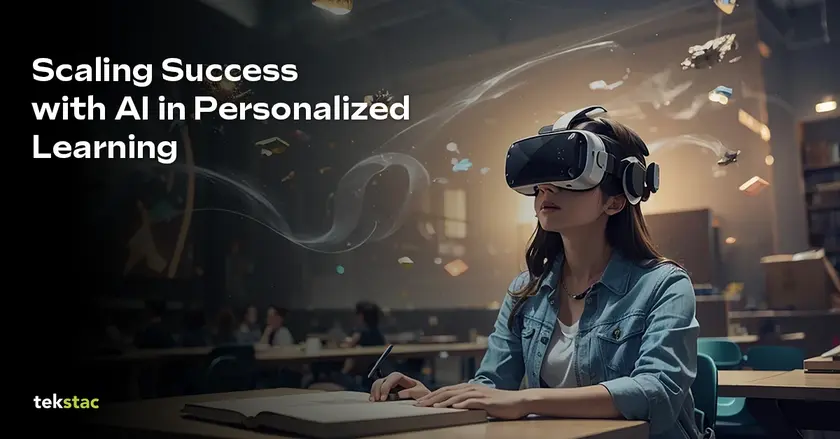How Tekstac Helps L&D Managers Hit Business KPIs Faster
Less than one in three skilling programs today directly impacts business KPIs. The rest? They keep churning out content. It’s no wonder that when L&D functions like a content factory, the business treats learning as optional.
To lead, L&D must become the capability engine: strategic and data driven.
While most of them still measure the traditional surface-level metrics such as:
- Completion rates
- Assessment scores
- Attendance numbers
These numbers still don’t answer the most important question: Did skill development actually change performance?
So how can L&D teams boost business KPIs efficiently?
That’s where platforms like Tekstac come into picture. See how Tekstac helps organizations in reaching learning and development KPIs.
Why Traditional L&D Metrics fail to deliver business KPIs?
Metrics like the number of hours trained or course completions are easy to measure but fail to capture the real training ROI measurement.
Let’s see why.
For instance:
- A team may complete a leadership program, but if decision-making doesn’t improve, is it worth the time?
- Employees may score high on assessments, but if sales numbers don’t change, did the learning truly stick?
L&D should replace activity tracking with meaningful skills gap analysis.
It means mapping current skills to business goals, finding critical gaps, and creating focused upskilling programs to close them.
This shifts L&D from spotting problems to solving them, building the right skills, in the right people, at the right time.
What Defines L&D Business KPI?
L&D business KPIs help organizations move from measuring participation to measuring performance change. Remember to identify the right KPIs for your L&D.
The role of KPIs in L&D:
- Provide visibility into the effectiveness of training programs
- Show measurable ROI on learning investments
- Highlight both strengths and areas for improvement
- Align L&D with organizational strategy
Common Challenges in Measuring Learning & Development KPIs
Did you know? According to the LearnOps Industry Report (2024)33% of organizations don’t make L&D success measurements at all.
Listed below are some of the common challenges faced in tracking business KPIs
1. Proving ROI
One of the biggest hurdles for L&D managers is convincing leadership, that training delivers value. Without robust data, learning is seen as a “nice-to-have” rather than a strategic growth driver.
2. Relying Too Much on Easy-to-Track Metrics
Attendance numbers and retention rates are simple to report, but they don’t tell the full story. True measurement requires both quantitative data (scores, completions, proficiency levels) and qualitative insights (employee satisfaction, perceived value, behavioral change).
Overcoming these challenges requires the right employee performance KPIs, the right measurement approach, and the right technology.
Top 3 Ways Your Teams Can Consistently Hit Business KPIs
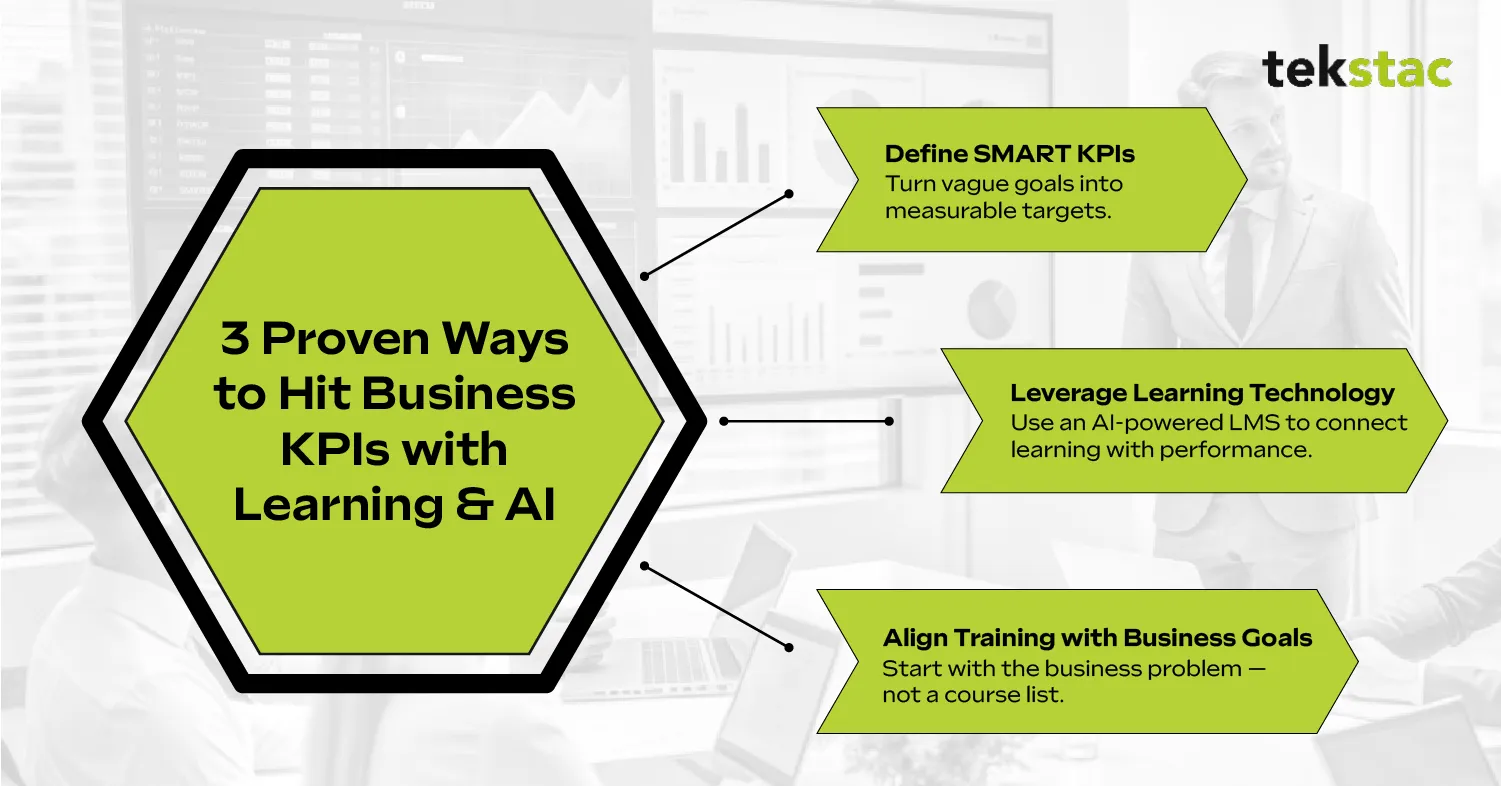
1. Define SMART KPIs
Instead of “Improve onboarding,” a SMART KPI would be “Reduce new hire ramp-up time by 20% within six months.”
2. Leverage Learning Technology
To truly measure and maximize the impact of learning, organizations need more than just training delivery—they need visibility, precision, and scalability. This is where an AI-powered Learning Management System (LMS) makes the difference and tracks upskilling impact on KPIs.
A AI-powered LMS can:
- Collect and centralize training data automatically
- Provide real-time dashboards on learner progress
- Personalize learning with skills gap analysis and adapting content
- Deliver insights instantly for leadership reporting
This shifts L&D from being reactive to proactively shaping workforce performance.
3. Align Training with Business Needs
Training should always start with a business problem, not a course catalog. Ask upfront:
- What challenge are we solving?
- Which learning and development KPIs will this training move?
- How will we measure success?
When learning initiatives are designed with these questions in mind, they not only engage employees but also prove their impact to stakeholders.
How Tekstac empowers you to track Business KPIs
Tekstac empowers L&D managers to link training directly to business performance through powerful learning analytics and management tools.
Why Tekstac:
- 360-degree platform with measurable ROI
- 500+ customizable, role-aligned learning paths
- Gamified experience with XP points, badges, and leaderboards
- AI-powered personalization & live dashboards
- Enterprise-grade security & compliance
- Data-driven skills insights
- Dual-layered assessments (auto + video with AI proctoring)
Enhanced learning experience with Tekstac
Beyond L&D success measurement, Tekstac powers learning delivery with:
- Personalized learning paths for every employee
- Mentor marketplace and virtual sessions
- Auto-evaluated practice labs
With 1 million+ professionals upskilled, 24 million+ learning hours, and enterprise clients like IBM, PwC, Capgemini, and Cognizant, Tekstac is proven at scale.
Where Skilling Meets Measurable Business KPIs
It’s time to stop tracking skill development for just the numbers. Instead of asking “Did employees finish the course?”, L&D managers must ask “What business KPI did this program improve?”
Track what matters and focus more on metrics stakeholders already value. Identify the employee performance KPIs before launching a program.
Need assistance with all this?
Tekstac transforms L&D from tracking hours and completions to driving measurable performance, stronger KPIs, and a future-ready workforce.
FAQs on business KPIs in L&D?
1. What are some examples of business KPI metrics in L&D?
Some examples for this include time to competency for new skills, utilizing acquired abilities in practical projects, Return on Learning Investment (ROLI).
2. What is KPI for L&D?
Learning and development KPIs are the steps you complete along the way in training. These KPIs for learning give you a meaningful way to quantify what good results are.
3. Which is a must track learning and development KPI?
One significant KPI one must track is training ROI, which measures the total value derived from training programs compared to their cost.
Tekstac vs Pluralsight: In-depth Feature and ROI Comparison
Imagine this: You’re leading L&D and need to decide how to spend your training budget. But you’re not sure how to measure if the programs are working. Sounds tricky, right? Actually, it’s not as hard as it seems. That’s where ROI comes in.
Every L&D leader today is looking at the cost v/s benefit of learning platforms to create a sustainable plan for the upcoming years.
Hence, choosing the right skilling platform that aligns with your goals becomes paramount. Here is a detailed ROI comparison between the two top-rated skilling platforms Tekstac and Pluralsight, to help you choose the right one.
ROI Comparison overview: Tekstac vs Pluralsight
When comparing Tekstac vs. Pluralsight, it’s crucial to understand their differences in content, certification, pricing, and learner focus. Both platforms cater to learners, but they differ in measuring corporate training ROI metrics.
Tekstac is an enterprise tech skilling platform with learning content, hands-on practice labs, assessments, ROI measurement dashboards and skills inventory tracking.
In contrast, Pluralsight specializes in 6,500+ tech-focused courses, tailored for IT professionals, developers, and engineers.
Who is Tekstac best for?
Tekstac is best suited for enterprises and learning leaders who need a 360-degree skilling platform to enable large-scale talent transformation. It is designed for organizations that want to upskill employees, accelerate role readiness, and track ROI on learning investments.
Who is Pluralsight best for?
Plural-sight is best for programmers, data scientists, data analysts, software engineers, computer engineers, IT professionals, and anyone in the tech workforce.
Here is the concise comparison table:
| Tekstac Features | Pluralsight Features |
|---|---|
The all-in-one platform features:
|
Prominent features include:
|
Tekstac vs Pluralsight: Which Platform Delivers Better ROI?
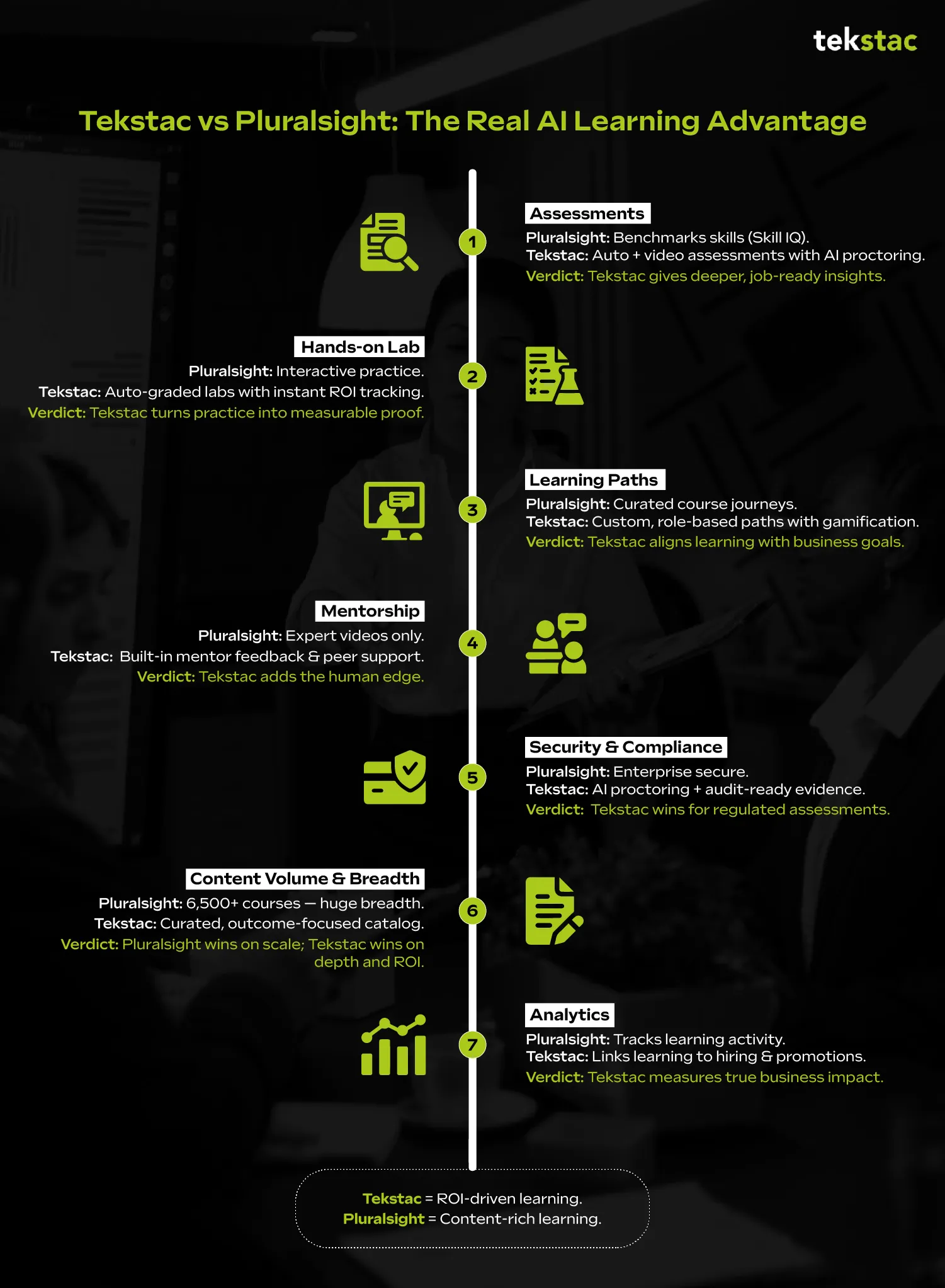
1. Assessments (What they measure and how they scale)
Pluralsight offers structured skill assessments (Skill IQ/Role IQ) to benchmark knowledge and recommend learning paths; these are useful for quickly measuring where a learner stands and for driving recommended content.
Tekstac, however, approaches assessment as a two-layered capability: instant, auto-evaluated assessments that gamify learning and deliver granular analytics, plus video assessments that evaluate communication, problem-framing, and applied thinking.
For companies doing a training ROI analysis, Tekstac provides a clearer picture of learner readiness and impact.
Verdict: Pluralsight’s Skill IQ provides a good benchmark, but Tekstac’s mix of auto-evaluated scoring, video responses, AI proctoring and mentor rubrics gives a richer, hire-ready assessment signal.
2. Hands-on labs and practice environments
Pluralsight has invested heavily in hands-on experiences: interactive labs, sandboxes, and in-browser code labs that let learners practice with cloud and desktop environments. These labs are great for isolated practice and platform familiarity.
Tekstac’s Auto-Evaluated Labs take it a step further, offering instant grading, personalized feedback, and corporate training ROI metrics by tracking skills acquisition in real time. Every submission is auto graded against test cases and performance metrics, with step-by-step personalized feedback and cohort analytics.
Tekstac’s labs are positioned as part of a continuous learning lifecycle, which reduces manual grading load and makes lab results usable as hiring or promotion evidence
Verdict: Pluralsight’s labs are excellent for practice; Tekstac’s auto-evaluation and integrated analytics convert practice into defensible proof of ability that clearly influences L&D ROI comparison.
3. Learning paths and personalization
Pluralsight’s core strength is a mature, searchable catalog and curated learning paths that guide learners from fundamentals to advanced topics, and the platform surfaces tailored recommendations based on assessment results.
Tekstac takes a different tack: instead of only offering pre-built paths, Tekstac promises 100% customizable, role-aligned learning journeys, LTI integration so existing third-party content can be unified, and gamified milestones to drive engagement. This ensures learning outcomes are directly tied to training ROI analysis.
Verdict: The combination of role mapping, gamification, and live dashboards means Tekstac’s paths can be tuned to business outcomes rather than just course completion.
4. Mentorship, human feedback and peer support
Pluralsight primarily scales through expert-authored video content and automated assessments; while it does offer guided learning experiences, direct mentoring/rubric-driven mentor review is not a core platform differentiator in the same way Tekstac makes mentoring part of the learning flow.
Tekstac’s Mentor Connect couples one-on-one and group mentoring, structured rubric feedback, and peer forums so learners get timely human guidance tied directly to assessment outputs. That human loop is especially valuable for borderline cases, candidate interviews, or nuanced technical topics where automated feedback can’t capture judgment or communication.
Verdict: Mentorship is blended into Tekstac’s product design, contributing to a higher Tekstac ROI, whereas Pluralsight focuses more on self-paced content and automated benchmarking.
5. Security, proctoring and enterprise compliance
Pluralsight markets enterprise features and governance for teams, and it’s widely used across companies for secure upskilling. But when it comes to integrated, assessment-level proctoring, that is not the headline differentiator Pluralsight promotes.
Tekstac’s Secure Proctoring Hub is designed natively into the assessment flow: AI monitors for impersonation, tab switching, unusual audio, produces confidence scores, and generates concise evidence packages for mentor review.
For regulated assessments, hiring decisions, or certification-grade testing, Tekstac’s approach reduces risk and administrative overhead while preserving learner experience. This level of compliance demonstrates the cost vs benefit of learning platforms in highly regulated environments.
Verdict: For high-stakes assessments and auditability, Tekstac’s native AI proctoring and reporting are stronger.
6. Content volume and course breadth
Here Pluralsight’s strength is indisputable: the platform advertises access to 6,500+ courses and thousands of hands-on labs and sandboxes, covering an exceptionally wide range of tech domains and vendors. For individual learners or teams who need breadth, Pluralsight’s catalogue is a compelling advantage.
Tekstac intentionally focuses on curated learning paths, role-aligned journeys and integrated assessment rather than quantity of discrete courses. If your priority is access to the largest possible library and immediate on-demand topic variety, Pluralsight gives more in volume
Verdict: Pluralsight has the upper hand here, when sheer scale and variety of course content are the deciding factor.
7. Analytics and business impact measurement
Pluralsight provides analytics and enterprise reporting (usage, skill gaps, role IQs) that help teams measure progress, but those analytics are principally consumption and assessment-level signals.
Tekstac layers skill-inventory analytics, cohort trend analysis, growth path analyzers, and ties assessment outputs (auto-graded labs + video rubrics + proctoring signals) to role readiness and hiring/upskilling decisions. The result is a product that not only shows who watched what, but shows who is demonstrably ready for a particular role or responsibility — and why.
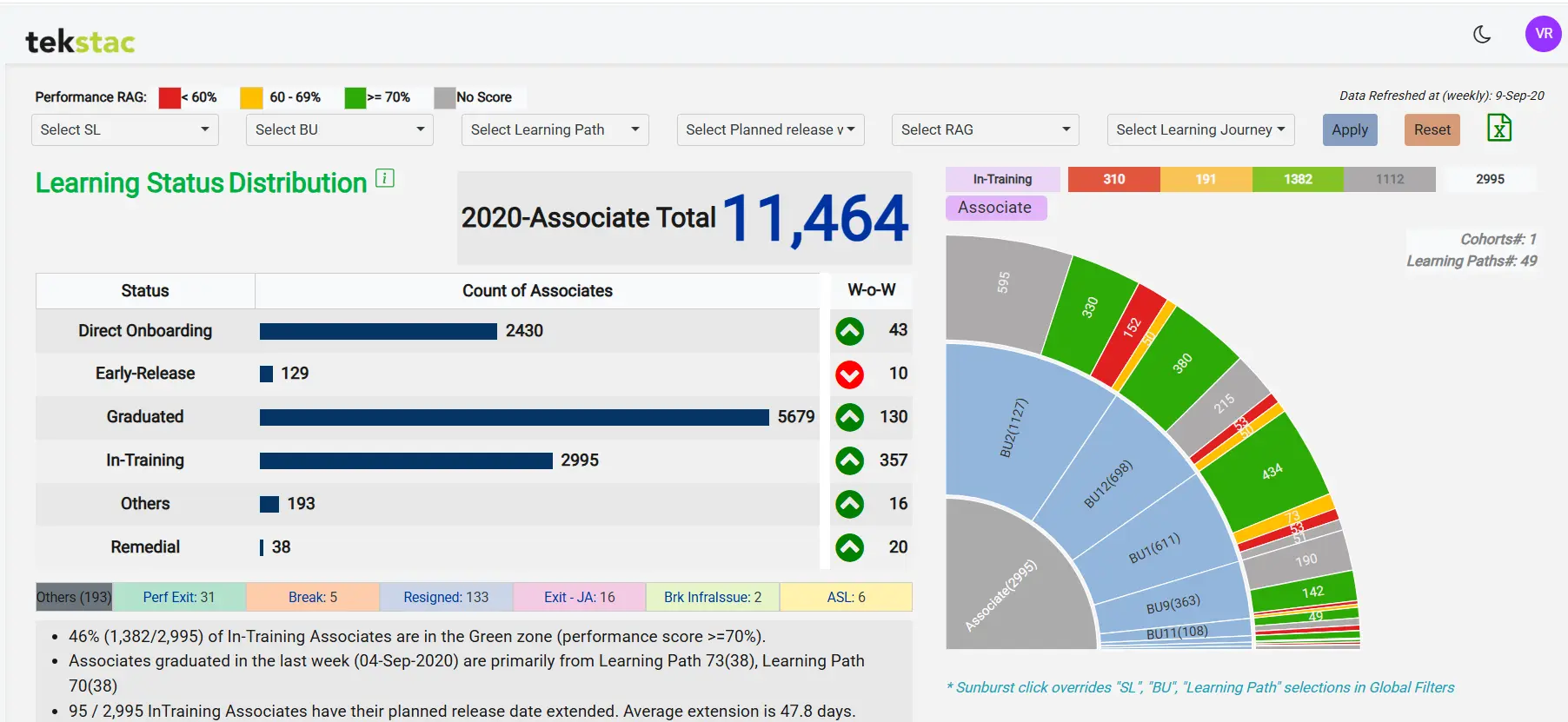
Verdict: Tekstac’s analytics are explicitly designed to drive HR and L&D decisions (hiring, promotions, targeted reskilling), not just measure activity.
Why do companies check Tekstac vs Pluralsight ROI comparison chart?
ROI measurement is not a cakewalk in L&D. You need to answer a lot of questions. How do enhanced skills impact the organization’s financial strength? How does the company scale with other competitors in L&D ROI comparison? And so on.
Tekstac v/s Pluralsight ROI comparison will give insights on how they compare to one another in one of the most crucial metrics.
Pluralsight ROI metrics
Pluralsight training ROI analysis suggests that a 295% return on investment (ROI) over three years, with organizations seeing full payback in under six months, according to a Forrester Total Economic Impact™ study.
The ROI is driven by faster onboarding, improved employee retention, and accelerated product development, resulting in millions in productivity gains.
Tekstac ROI metrics
Unlike Pluralsight’s ROI comparison, Tekstac measures learning impact through skills outcomes, productivity, retention, and alignment with business goals.
Tekstac supported 110,000+ learners for one of its leading tech clients, improving talent identification, reducing hiring and training costs, accelerating productivity, boosting engagement, optimizing program management, and improving ROI.
Tekstac builds evolving, real-time skill profiles (“SkillTag”) per learner, integrating assessments and workplace data to inform talent strategies.
Final Thoughts: ROI Comparison and Key Takeaways
Both Pluralsight and Tekstac are top upskilling platforms—Pluralsight with expert-led learning, and Tekstac with real-world coding practice.
So, what’s right for you?
Pluralsight remains an industry leader for individuals and teams looking for an expansive, expertly authored course library with hands-on practice options. If your top priority is content breadth and immediate access to thousands of tech topics, Pluralsight is the safer pick.
But for organizations that is looking not just content but a comprehensive skill development platform that includes assessments to mean something (beyond “course complete”), want labs that act as verifiable proof of capability, require low-friction, enterprise-grade proctoring, and value human mentoring tied directly to analytics and role outcomes, Tekstac is the more outcome-oriented platform. Most importantly, Tekstac empowers the organization’s L&D teams with proven ROI that is clear and actionable.
Frequently Asked Questions on ROI Comparison
1. What is ROI in L&D?
ROI in Learning & Development is a way to measure how much value your organization gets from investing in employee training and development.
2. What factors influence L&D ROI comparison in companies?
Several factors impact L&D ROI comparison, including relevance of learning content, engagement levels, skill application on the job, and alignment with career progression or internal mobility goals. Platforms that integrate assessments, mentorship, and analytics, like Tekstac, provide richer insights for comparing ROI and making informed talent decisions, including promotions and lateral hiring.
3. How can organizations measure training ROI effectively?
Training ROI can be measured by tracking improvements in employee performance, time-to-competency, internal mobility readiness, and impact on business outcomes.
26 Key Takeaways from HR Tech 2025: Insights from the Leaders
The HRTech 2025 conference, a gathering of global HR leaders and innovators, highlighted the trends, challenges, and breakthroughs shaping the future of work. We’ve compiled 26 key HR insights from sessions, panels, and conversations with leading voices.
These insights are organized into seven themes that capture the latest trends shaping HR. Let’s take a look.
7 Themes Shaping the Future of HR Insights
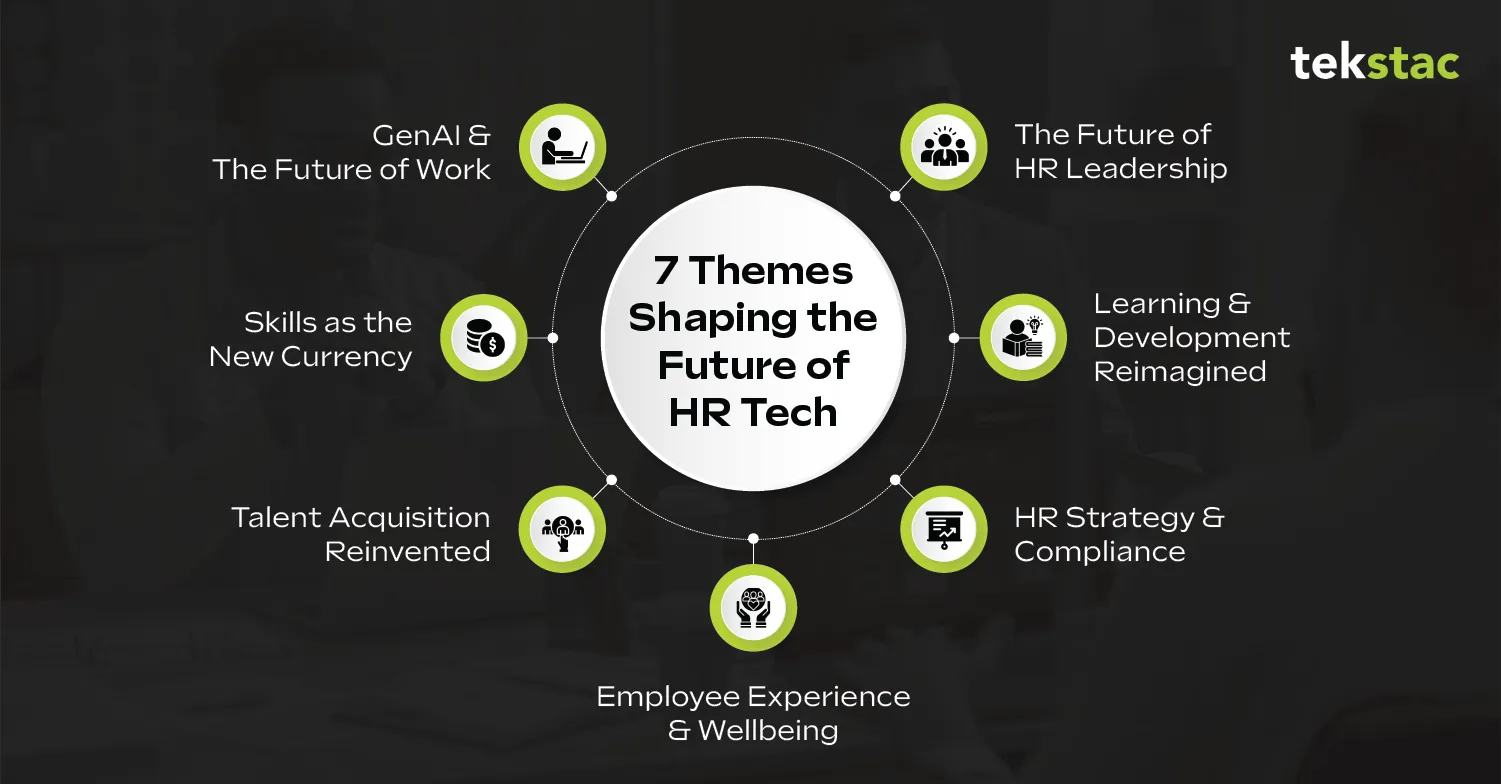
Theme 1: Talent Acquisition Reinvented
1. Candidate experience is now AI-enhanced
Discovery: Phenom and Paradox showcased GenAI-powered candidate communication—automated but personalized.
Why it matters: Candidate drop-offs happen when the process feels impersonal or slow. AI can help close that gap.
Action: Audit your candidate journey for speed, personalization, and human touch.
Quote: As Yvette Cameron (Oracle) noted, “The future of AI in enterprise software will become more conversational,” fundamentally changing how candidates and employees interact with HR systems.
2. Hiring is about quality, not quantity
Quote: “The talent shortage isn’t about numbers — it’s about skills alignment.”
Why it matters: Recruiting strategies must focus on quality hires and internal mobility, not endless sourcing.
Action: Build “talent intelligence” dashboards that connect hiring with performance.
Added insight: Kathi Enderes (Josh Bersin Company) challenged, “How can we make every person count more?” emphasizing outcomes over sheer headcount.
3. Assessments go AI-first
Discovery: Platforms like SHL, Pymetrics, etc., are using adaptive AI-driven assessments to personalize difficulty and reduce bias.
Why it matters: Fairness and scalability in hiring depend on intelligent assessment tools.
Action: Replace one-size-fits-all assessments with adaptive, feedback-driven models.
Quote: Robin Barbacane (Rackspace) said, “When you first create your AI tool, talk to it like an intern,” highlighting practical ways to integrate AI safely.
4. Internal mobility is the new sourcing strategy
Stat: 65% of companies invest in improving manager and employee mobility experiences (Aptitude Research).
Why it matters: Moving people internally is more cost-effective and improves morale.
Action: Create internal job boards and mobility marketplaces.
Quote: Josh Gosliner (SAP) reminded us, “HR data can’t live in silos anymore,” reinforcing the need for connected internal talent strategies.
Theme 2: Skills as the New Currency
5. Skills-based strategies dominate HR agendas
Stat: 58% of companies prioritize skills-based hiring and internal mobility.
Discovery: Platforms like Eightfold, Gloat, and SkyHive showcased live skills graphs linking learning to career paths.
Action: Start with a skills baseline; Platforms like Tekstac make this easier by capturing learning performance data that reflects actual skill growth, helping organizations keep their skills business aligned.
Quote: Heidi Barnett (isolved, Talent Acquisition) advised, “Think about complementary skills and help describe who a job would be perfect for.”
6. Career pathing becomes skills-driven
Quote: Madeline Laurano noted, “Employees don’t want a static career ladder—they want dynamic growth journeys based on skills.”
Why it matters: Retention improves when employees see a personalized path forward.
Action: Use platforms that visualize “if you learn X, you can move into Y role.”
7. Pay transparency and skills-linked compensation rise
Discovery: Vendors like Visier, CompXL link pay to skills, not just job titles.
Why it matters: It’s a fairness and DEI issue—and reduces bias in compensation.
Action: Explore skills-based compensation frameworks.
Quote: Heather Kruger (Salary.com) reminded, “Compensation is the foundation—organizations won’t get to higher-order culture dynamics if they don’t get the foundation right.”
Theme 3: Learning & Development Reimagined
8. AI-personalized learning becomes default
Discovery: Platforms like Tekstac, Cornerstone, and Docebo embed adaptive learning journeys that adjust pacing, difficulty, and content.
Why it matters: Personalized learning improves retention, satisfaction, and outcomes.
Action: Shift toward adaptive learning paths tailored to performance and career goals.
Quote: Sandra Loughlin, PhD observed, “Real learning happens in practice, feedback, and flow—not just through structured content.”
9. Skills verification is critical
Discovery: Tools like Degreed, Credly, and blockchain-based platforms offer verifiable skill credentials.
Why it matters: Employers want proof of capability, not just course completion.
Action: Incorporate verifiable assessments into programs.
10. ROI in L&D is finally measurable
One of the panelists quoted: “The ROI black hole is closing AI gives us real business outcome tracking.”
Why it matters: Learning is expected to drive promotion, performance, and retention.
Action: Tie learning outcomes to business metrics.
Quote: Jason Averbook emphasized, “In 2025-26, HR needs a reset. Otherwise, we’re putting digital lipstick on an analog pig.”
Theme 4: Employee Experience & Wellbeing
11. EX platforms become central hubs
Discovery: ServiceNow, Qualtrics, and Microsoft integrate surveys, workflows, and learning.
Why it matters: Employees expect consumer-grade experiences at work.
Action: Invest in EX platforms that unify communications, HR tasks, and career tools.
12. Managers are the new power users
Gartner found that among HR decision-makers, leader and manager development remains the number one priority.
Action: Give managers AI copilots for feedback, coaching, and visibility.
Quote: Bill Pelster, Amber Grewal, and Jaclyn Zhuang shared that managers may lead both people and digital agents, emphasizing hybrid leadership skills.
13. Mental health tech grows mainstream
Discovery: Vendors like Modern Health and Spring Health integrate AI for personalized well-being nudges.
Why it matters: Burnout is a top turnover driver.
Action: Embed well-being into daily workflows.
Quote: Ami Graves said, “Without trust and strong leadership skills in our companies, the technology and AI implementations that we want to implement will fail.”
Theme 5: HR Strategy & Compliance
14. Payroll innovation is back
Discovery: ADP and CloudPay offer real-time pay and AI-driven anomaly detection.
Why it matters: Payroll errors erode trust quickly.
Action: Evaluate tools for speed, fairness, and reliability.
Quote: Pim Altena (Remote) warned, “Trust has a timestamp,” highlighting the link between accuracy and credibility.
15. Trust is the new HR currency
Quote: Josh Bersin emphasized, “Without trust, none of this tech matters.”
Action: Communicate openly about AI and data usage.
16. HR Tech spend is accelerating
Stat: 75% of companies plan to increase HR tech budgets.
Action: Build a strong ROI narrative.
17. Vendors consolidate, but innovation thrives
Discovery: Big HR tech players are expanding fast: Workday acquired Sana, Deel bought Assemble, Paychex snapped up Paycor, Dayforce went private with Thoma Bravo, and HiBob added Pento and Mosaic—while startups keep innovating in niche areas like payroll, AI, and skills taxonomies.
Action: Pilot with smaller players when innovation matters.
Theme 6: GenAI & The Future of Work
18. GenAI moves from hype to workflows
Discovery: Workday, Phenom, and Eightfold showcased enterprise-ready GenAI features.
Why it matters: 64% of HR leaders see GenAI as essential.
Action: Start with low-risk, high-impact areas.
Quote: Nickle LaMoreaux (IBM) said, “It’s HR’s moment in the sun,” urging leaders to seize AI opportunity proactively.
19. Responsible AI is the competitive advantage
Quote: Josh Bersin: “Transparency, bias management, and trust will define which vendors win.”
Action: Audit AI explainability.
20. From chatbots to copilots
Discovery: Microsoft Copilot in Viva, Workday’s AI agent features.
Action: Train teams to collaborate with AI as a partner.
Quote: Kyle Forrest emphasized, “You can’t slap AI solutions on top of existing processes,” underlining the need for integration.
Theme 7: The Future of HR Leadership
21. HR leaders as transformation architects
Action: Upskill HR teams on data literacy, AI fluency, change management.
Quote: Patrick Leddin, PhD, asked, “Do I move towards the change, or do I move towards stability?”—guiding leaders to embrace uncertainty.
22. DEI strategies shift from programs to platforms
Discovery: Textio, Unitive, and certain ATS platforms integrate inclusive language and bias detection.
Action: Audit tools for bias.
23. Hybrid work tech stabilizes
Discovery: Microsoft, Zoom, Slack show hybrid tools as core utility.
Action: Invest in tech that supports hybrid collaboration.
24. Data privacy becomes HR’s responsibility
Action: Collaborate with legal and IT; secure sensitive employee data.
25. Employees expect skills transparency
Discovery: Platforms show employees their skill gaps and potential career paths.
Action: Give employees access to their own skills data.
26. HR must lead, not follow
Quote: Josh Bersin: “This is HR’s time. Don’t wait for tech vendors to define the future — build it yourself.”
Why it matters: Being proactive shapes culture, tools, and strategy.
Quote: Sarah Hodges (UKG) added, “HR tech is the bridge between ideas and outcomes,” reinforcing the strategic impact of HR.
Turning HR Insights into Action
At Tekstac, we see HR Tech 2025 as more than an event; it’s a reflection of how innovation, skills, and strategy are converging. And that’s exactly where our focus lies. The conference brought together industry’s best minds, covering HR insights, innovations, and technology to help organizations stay ahead of change and build the future-ready workforce of tomorrow.
26 AI Tools That Will Reshape HR Tech in 2026
Selecting the right HR Tech tool is crucial to optimizing processes and achieving organizational goals. With countless options available, choosing the best tools requires careful consideration.
Here’s your ultimate list of 26 AI tools that will help you streamline HR processes, boost employee experience, and drive measurable business impact.
Let’s dive in, category by category.
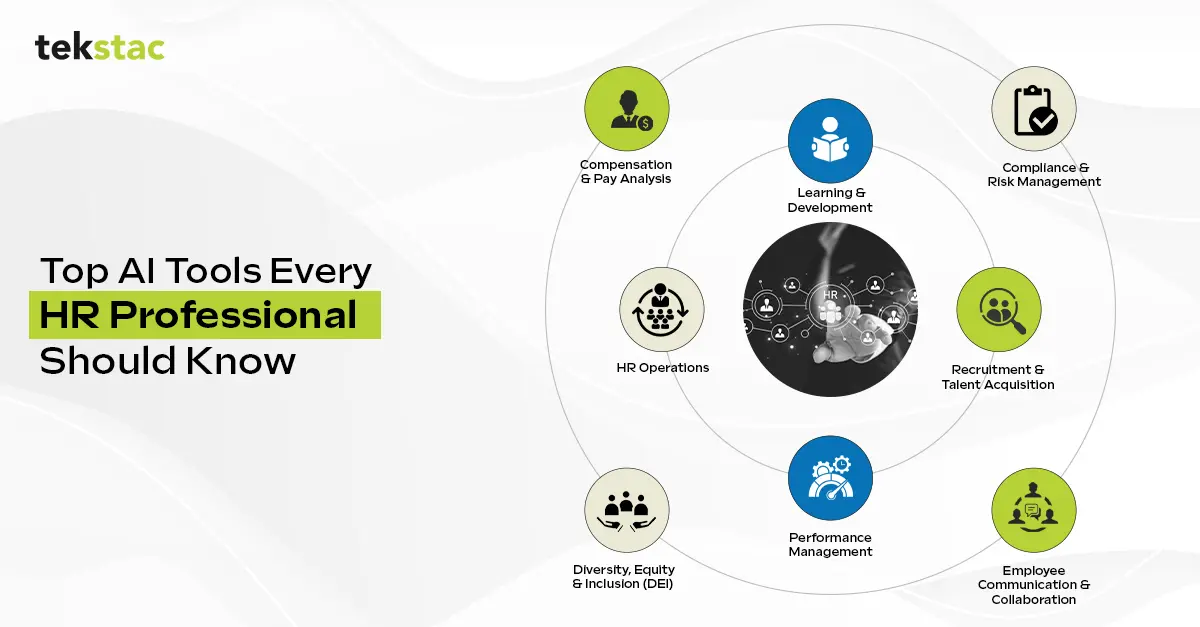
Comparison of 26 Leading AI Tools for HR Automation
| Category | Company Name | Pricing |
|---|---|---|
| Learning & Development | Tekstac | Custom pricing |
| Degreed | Custom pricing | |
| Fuse Universal | Starts at $25,000 annually | |
| Recruitment & Talent Acquisition | LinkedIn Talent Insights | $170/month (single license); $270/month per license (licenses 2–5); $1,680/year (single license); $2,670/year (licenses 2–5) |
| Pymetrics | Starts at $10,000 annually | |
| SeekOut | Basic: $499/month; Pro: $999/month; Enterprise: $1,999/month | |
| HireVue | Entry-level plans start at $39/month | |
| Performance Management | Effy AI | Free for up to 5 members; $6–$8 per seat/month for employee reviews; $3–$7 per seat/month for performance and 360° reviews |
| ClearCompany | Custom pricing | |
| HR Operations | Leena AI | Custom pricing |
| BambooHR | Starts at $99/month for 12 users; additional users at $8.25/user/month | |
| Praisidio | Custom pricing | |
| Lattice | Starts at $11/user/month; custom pricing for larger organizations | |
| Monday.com | Basic: $49/month for 10 users; Standard: $79/month; Pro: $119/month; Enterprise: custom pricing | |
| Zapier | Free plan available; paid plans start at $19.99/month | |
| UiPath | Custom pricing | |
| Compliance & Risk Management | HR Acuity | Custom pricing |
| Compliance.ai | Custom pricing | |
| BrightMine | Custom pricing | |
| Employee Communication & Collaboration | Workday | Custom pricing |
| Slack | Free plan available; paid plans start at $6.67/user/month | |
| Trello | Free plan available; paid plans start at $5/user/month | |
| Diversity, Equity & Inclusion (DEI) | Asana | Free plan available; paid plans start at $10.99/user/month |
| Diversio | Custom pricing | |
| Blendoor | Custom pricing | |
| Compensation & Pay Analysis | PayScale | Custom pricing |
Learning & Development
1. Tekstac
Best For: Organizations seeking verifiable upskilling, measurable ROI, and business-aligned learning outcomes.
Standout Feature: Dual-layered assessments (auto + video with AI proctoring)
How it Works
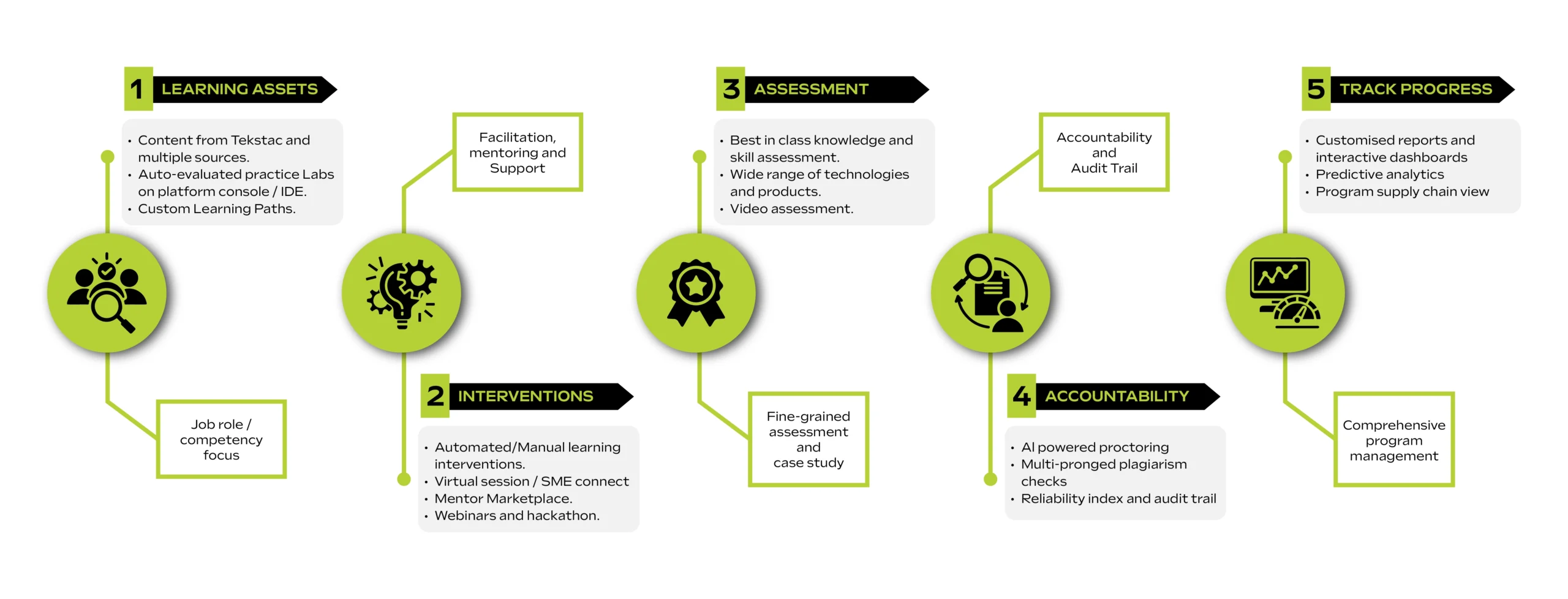
Tekstac Features:
- 360-degree platform with measurable ROI
- 500+ customizable, role-aligned learning paths
- Auto-evaluated coding labs with instant grading
- Mentor marketplace with structured rubric feedback
- Gamified experience with XP points, badges, and leaderboards
- AI-powered personalization & live dashboards
- Enterprise-grade security & compliance
- Data-driven skills insights
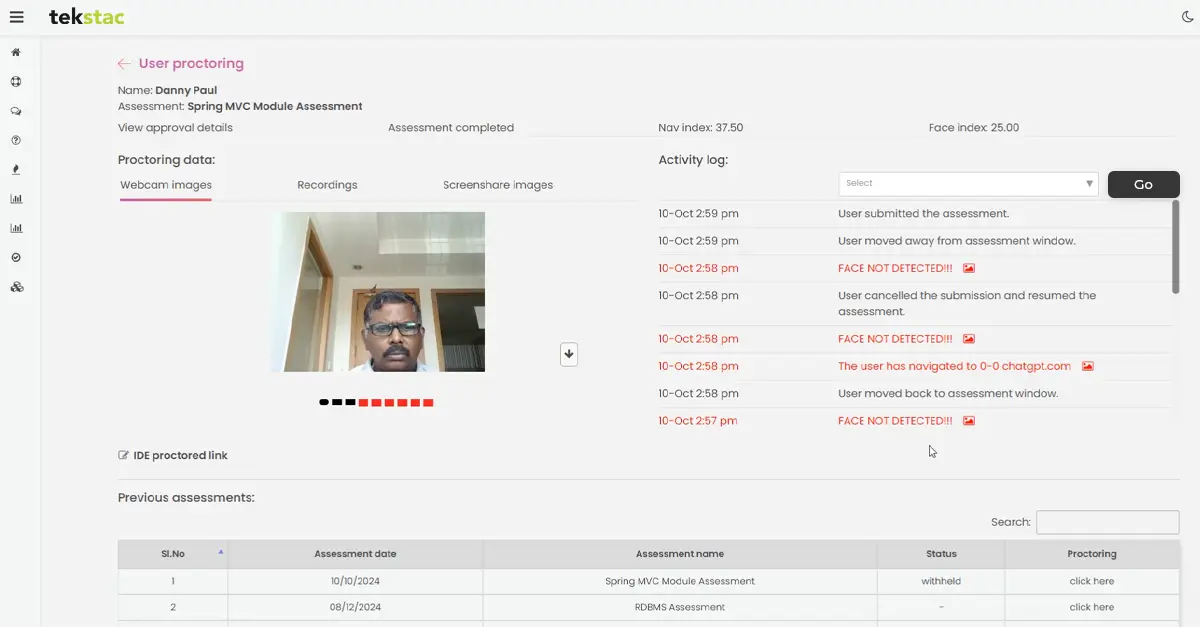
2. Degreed
Best For: Organizations that want to centralize learning, upskilling, and continuous education
Standout Feature: Highly flexible learning pathways and personalized content recommendations.
Features:
- Personalized learning pathways combining internal & external content
- Aggregation of diverse learning resources (books, podcasts, courses)
- Easy-to-use UI & third-party integration
3. Fuse Universal
Best For: Organizations and L&D teams building a culture of continuous learning.
Standout Feature: AI-powered personalized learning journeys + social learning.
Features:
- AI recommendations based on role, skills, interests, goals
- Unified content hub (internal, external, user-generated)
- Microlearning & curated modules for busy schedules
Recruitment & Talent Acquisition
4. LinkedIn Talent Insights
Best For: HR leaders, recruiters, and organizations seeking data-driven workforce planning
Standout Feature: Real-time insights on talent availability and workforce trends
Features:
- Talent Pool & Company Reports
- Competitive Benchmarking
- Skills & Location Mapping
5. Pymetrics
Best For: Talent acquisition teams looking for bias-free candidate evaluation
Standout Feature: Neuroscience-based games assessing cognitive & emotional traits
Features:
- AI-driven gamified assessments
- Candidate profiling beyond resumes
6. SeekOut
Best For: Companies prioritizing diversity hiring
Standout Feature: Advanced AI filters for diversity & real-time skills analysis
Features:
- AI-powered candidate sourcing
- Searches public databases & networks
- Advanced diversity filters
7. HireVue
Best For: High-volume recruitment across industries
Standout Feature: AI insights into candidate personality & cultural fit
Features:
- AI-powered video interviewing
- Analyzes facial expressions, tone, word choice
- Customizable evaluation metrics
Performance Management
8. Effy AI
Best For: Growing companies streamlining performance reviews
Standout Feature: Complete 360-degree review in just 60 seconds
Features:
- Quick setup for reviews
- Automates questionnaires & participant matching
- AI-generated reports & Slack integration
9. ClearCompany
Best For: Companies fostering continuous improvement & data-driven performance
Standout Feature: AI-powered alignment of individual & team goals
Features:
- Goal tracking & 360-degree feedback
- Performance analytics & insights
HR Operations
10. Leena AI
Best For: Large/distributed enterprises with high HR query volumes
Standout Feature: “Siri for employees” – instant query resolution
Features:
- 24/7 AI-powered HR assistant
- Integrates with HRIS like Workday & SAP
- Automates FAQ responses
11. BambooHR
Best For: Small to mid-sized companies seeking efficient HR automation
Standout Feature: End-to-end AI automation of HR workflows
Features:
- Employee records & payroll automation
- Benefits tracking & HR workflow automation
12. Praisidio
Best For: HR leaders seeking insights to improve recruitment & retention
Standout Feature: AI-driven organizational insights
Features:
- Unified HR database
- Step-by-step HR process assistant
- Integrates with platforms like ADP, Workday, Lattice
13. Lattice
Best For: Organizations with existing HRIS wanting predictive workforce insights
Standout Feature: Context-aware AI Agent for trends, risks, & insights
Features:
- Pattern detection & insights
- Workflow integration & meeting assistant
14. Monday.com
Best For: HR teams automating onboarding, approvals, tasks, & status tracking
Standout Feature: Pre-built automation recipes + deep integrations
Features:
- Workflow automation with pre-set triggers & actions
- Multiple board views (Kanban, Calendar, Gantt)
15. Zapier
Best For: HR teams looking to automate repetitive tasks
Standout Feature: AI-powered “Zaps” for workflow automation
Features:
- Connects apps & reduces manual data entry
- Customizable automation workflows
16. UiPath
Best For: Enterprises with repetitive, large-scale HR/back-office tasks
Standout Feature: Robotic Process Automation (RPA) with AI task execution
Features:
- Builds software robots mimicking human actions
- Integrates with existing systems
Compliance & Risk Management
17. HR Acuity
Best For: HR/employee relations teams seeking compliant & proactive case management
Standout Feature: AI-driven executive summaries & trend reporting
Features:
- Case management for investigations
- Smart interview question generation
- Multilingual support & analytics
18. Compliance.ai
Best For: Highly regulated industries (finance, healthcare)
Standout Feature: Real-time legal & regulatory AI alerts
Features:
- NLP for regulations
- Tracks legal updates &alerts
19. BrightMine
Best For: Enterprises operating across multiple geographies
Standout Feature: AI Assist with access to 23,000+ HR resources
Features:
- Automates compliance tasks
- Provides AI-powered HR resources
Employee Communication & Collaboration
20. Workday
Best For: Organizations modernizing HR with AI efficiency & inclusivity
Standout Feature: Holistic AI integration across all HR functions
Features:
- Personalized learning & skill development
- Employee engagement & sentiment analysis
- AI HR support chatbots
21. Slack
Best For: Remote-first & hybrid teams
Standout Feature: AI-generated conversation recaps
Features:
- AI-powered personalized search
- Summarizes conversations & missed messages
22. Trello
Best For: HR teams managing projects & onboarding tasks
Standout Feature: AI-powered task automation with visual workflow boards
Features:
- AI-powered project management
- Task assignment & tracking
23. Asana
Best For: Teams improving project execution & productivity
Standout Feature: AI converts notes into actionable tasks & predicts optimal timelines
Features:
- Intelligent task management
- NLP-based note-to-task automation
- Workflow bottleneck detection
Diversity, Equity & Inclusion (DEI)
24. Diversio
Best For: Organizations improving DEI across teams & geographies
Standout Feature: Real-time DEI metric tracking with AI recommendations
Features:
- AI-driven DEI data tracking
- Surveys & targeted questions
25. Blendoor
Best For: Organizations committed to equitable recruiting & bias reduction
Standout Feature: Anonymized hiring filters + equity-focused analytics
Features:
- Candidate evaluation without demographic identifiers
- Transparent filters & analytics
Compensation & Pay Analysis
26. PayScale
Best For: Organizations seeking competitive & equitable compensation strategies
Standout Feature: Real-time market data for informed salary decisions
Features:
- Advanced search & survey participation
- Data transparency & validation
The Impact of AI Tools on Modern HR Strategy
With the 26 AI tools outlined above, HR leaders can identify solutions that align with their specific needs, whether it’s boosting employee engagement, fostering continuous learning, reducing bias in hiring, or optimizing workforce planning.
Among these, Tekstac stands out in HR Tech for its dual-layered assessments, AI-powered personalization, and data-driven skills insights, making it ideal for organizations that want measurable ROI from learning programs, verifiable upskilling, and business-aligned outcomes.
The Learning Shift in Action: How Companies Win with L&D Transformation
In boardrooms and on the front lines, a quiet revolution is underway.
The world of corporate Learning & Development (L&D), once a predictable function of compliance checklists and scheduled seminars, is undergoing a seismic shift. The old playbook of delivering training for the sake of coverage is being replaced by a far more ambitious mandate: build capability.
It’s less about pushing content into people’s calendars and more about creating ecosystems where employees are pulled toward growth because they see the direct value in it.
This learning transformation is the heartbeat of The Learning Shift, a new LinkedIn series by Tekstac featuring insights from seasoned L&D leaders. It’s not just an internal shuffle or a passing trend. It’s a strategic imperative for any organization aiming to thrive in an era defined by disruption, rapid technological change, and shifting workforce expectations.
The consensus from the leaders we spoke to is unmistakable: L&D is moving from a support service to the engine room of business agility and resilience.
Learning Shift Mandate: From Training Provider to Strategic Capability Builder
The role of L&D has fundamentally expanded.
As DJ Jaeger, Senior Training Manager at Akamai Technologies, puts it: “L&D is becoming a strategic driver of organizational capability, not just a service provider.” The expectation has shifted from simply “doing more with less” to “delivering greater impact with less.”
That’s not just semantics; it’s a mindset shift. It means moving beyond measuring success by course completions and attendance sheets. Instead, the focus is on fostering genuine skills, workforce agility, and adaptability priorities that have firmly landed on the board’s agenda.
But here’s the thing: strategic alignment doesn’t happen by accident.
Meeta Kanhere, a leadership consultant, points out a critical blind spot in many organizations: a lack of clarity on the why behind workplace learning. Before engaging consultants or launching a program, leaders must articulate what success looks like.
Without that clarity, L&D risks operating in a vacuum, designing elegant solutions to problems no one has defined. The most impactful learning strategies emerge when L&D partners with the business to diagnose challenges, define desired outcomes, and co-own the results.
Imagine two scenarios:
- In one, L&D rolls out a new leadership program because “we need more leaders.” The result? Mixed engagement, vague metrics, and little change in behavior.
- On the other hand, L&D starts by asking, “What capabilities will leaders need to take this business through its next phase of growth?” From there, they co-design experiences that directly address those needs. The difference is night and day, and so are the results.
AI as the Co-Pilot: Amplifying Human Potential
No conversation about the future of L&D can ignore Artificial Intelligence.
Its role, however, is widely misunderstood. Santosh Akella, an L&D professional and keynote speaker, frames it perfectly: “AI should be the co-pilot, not the pilot.”
AI’s value lies in the heavy lifting of curating content, identifying skill gaps, and automating time-consuming administrative tasks. DJ Jaeger adds that AI can handle taxonomy management, smart tagging, and even initial learning path creation, freeing L&D professionals to focus on higher-order work: engaging learners, coaching leaders, and shaping culture.
For Aveshkumar Jha, Global Head of Organization Development at Hinduja Global Solutions, the message is blunt: “Stop fearing technology. Embrace it. Befriend it.”
L&D leader Sheena backs this up with data, pointing to research that shows how AI powered adaptive learning can dynamically adjust content based on a learner’s pace, preferences, and performance. That turns skills development from a generic exercise into a deeply personalized growth journey. An employee struggling with a new sales process is automatically recommended targeted simulations and peer-led case studies, while another who’s excelling is served advanced modules and mentoring opportunities. Both are engaged, challenged, and supported at scale.
The Great Shift: From Push to Pull Learning
Perhaps the most profound change in modern learning is the shift from “push” to “pull.” For decades, corporate learning was built on a push model of mandatory modules, compliance checklists, and quarterly workshops. Employees participated because they had to.
But today’s workforce, especially Millennials and Gen Z, learns differently. They expect learning to be on-demand, relevant, and embedded into the flow of work. As Santhosh puts it: “An employee facing a tough client call won’t wait for the next webinar; she’ll find what she needs right now.”
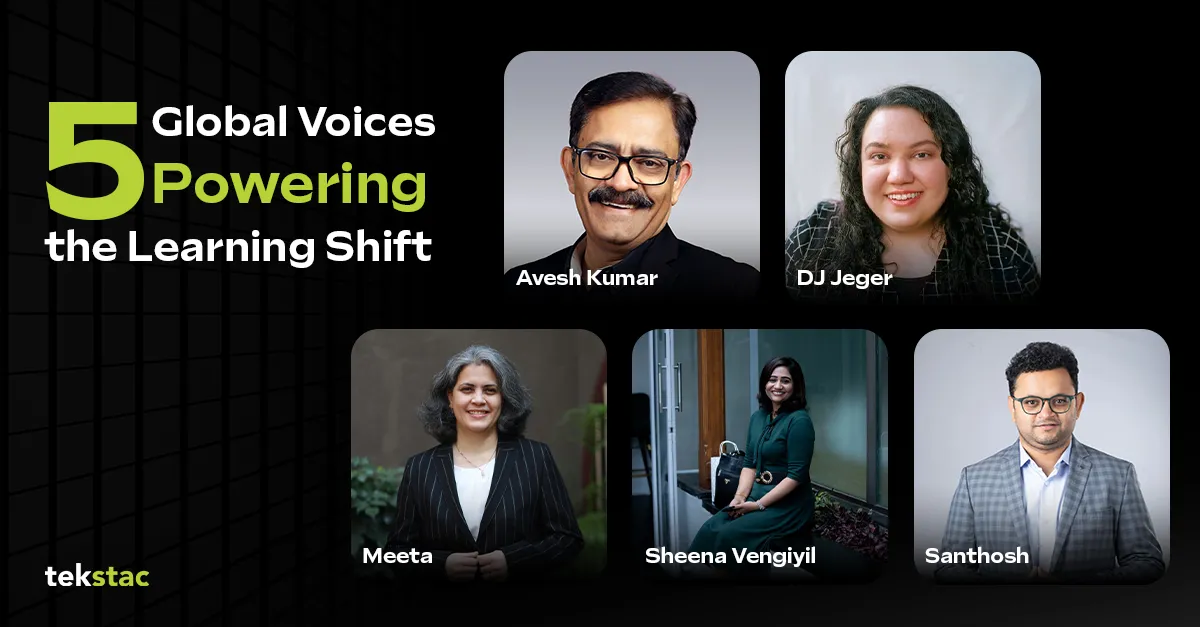
This is pull learning when employees actively seek out knowledge and skills because they see immediate value.
Avesh explains that employees want learning that speaks directly to their current roles, future ambitions, and personal interests. They prefer formats they can consume in short bursts, bite-sized videos, quick simulations, or peer discussion threads.
Sheena’s research shows that microlearning often outperforms traditional training in both engagement and retention. And when it’s integrated into the tools people already use, like Microsoft Teams or Slack, it becomes part of the workday rather than an interruption.
Social learning, too, is gaining ground. Peer-led communities and collaborative forums don’t just distribute knowledge; they strengthen culture and boost application. In fact, Sheena cites data showing that social learning can improve on-the-job application by up to 75%*.
The question for leaders, Santhosh says, must evolve from “How do we make them complete this course?” to “How do we make them want to?”
*According to the 2023 Brandon Hall Group Study.
The Irreplaceable Human Core in a Digital Age
For all the excitement around AI and automation, the human element remains the anchor of impactful learning.
Santhosh reminds us: no algorithm can replace the spark of a great mentor, the resonance of a compelling story, or the thrill of discovery.
Sheena points to psychological safety as a crucial driver of deeper learning. When people feel safe to ask questions, challenge ideas, and admit mistakes without fear of judgment, they engage more fully and innovate more freely.
Avesh adds a deceptively simple truth: learning sticks when it’s fun. Whether through gamified simulations, creative challenges, or interactive storytelling, enjoyment deepens retention.
DJ Jaeger notes that coaching, once reserved for executives, is now being democratized. Everyone, from entry-level employees to mid-career professionals, can benefit from personalized guidance. This doesn’t just accelerate skill development; it reinforces a continuous learning culture where growth is accessible to all.
The Road Ahead: Driving Business Growth Through L&D Transformation
The path forward demands courage, experimentation, and a willingness to lead from the front.
DJ Jaeger cautions leaders against a “wait and see” stance on innovation, especially with AI. The bigger risk, he argues, is being left behind. Early adopters have the advantage of shaping the tools to fit their culture and needs.
Meeta warns against common pitfalls: making decisions driven purely by short-term cost savings, underestimating the importance of sustained sponsorship, and neglecting the creation of internal champions who can carry momentum forward.
In the end, L&D transformation won’t just imply the number of training courses. As DJ Jaeger puts it: “Your legacy isn’t the content you create; it’s the capability you build.”
That’s the real measure of success in the new era of learning: whether your people are more adaptable, more confident, and more capable of taking on tomorrow’s challenges than they were yesterday.
The Learning Shift: What It Means for Your Business
The learning shift is not a memo you send out. It’s a cultural rewire. It’s the difference between a workforce that survives change and one that drives it. And it starts with leaders willing to see L&D not as a cost center, but as the architect of the future.
Tekstac empowers L&D professionals with a 360 degree end to end skilling platform to stay current with rapidly changing technologies. See our mission in action.
This article brings together insights from industry leaders who are shaping the future of learning and development. Below are the voices behind these perspectives—leaders whose experiences across global organizations, startups, and academia offer a rich view of how capability-building is evolving in the GenAI era.
Avesh Jha is Senior Vice President of Global Organizational Development & Performance Management at Hinduja Global Solutions. With 30+ years of global experience, he specializes in leadership development, performance management, and guiding large-scale business transformations.
Sheena Vengiyil is Learning Lead for the India GCC Business at Maximus and a 2024 HR 40 Under 40 honoree. She brings 16 years of expertise in designing impactful learning strategies across global organizations.
DJ Jaeger is Senior Training Manager for Customer Learning and M&A at Akamai Technologies and an adjunct instructor at Portland State University. She focuses on enterprise learning systems, upskilling programs, and inclusive workplace practices.
Meeta Kanhere is Co-Founder of Meraki Leadership Solutions and a seasoned consultant in leadership and organizational development. She works with organizations to build high-performance teams and value-driven cultures.
Santosh Akella is Assistant Manager – L&D at Cognitus and a former president of the Hyderabad Chapter of the Professional Speakers Association India. He is known for creating coaching cultures and designing learning programs that align with business goals.
7 Learning and Development Trends Shaping Enterprise Strategy in 2026
Discover the 7 learning and development trends for upskilling in 2026, from AI-driven to VR training and continuous learning. Try to stay ahead in that bell curve and succeed in your career!
What Are the Top Learning and Development Trends for 2026?
With growing dependencies on Gen AI, learning & development departments will continuously evolve in 2026. In order to stay relevant in the growing market, it’s imperative to follow the latest trends and be a part of a futuristic workplace.
So, what are the top Learning and Development Trends for 2026?
The leading L&D trends include AI-driven upskilling, hyper-personalized learning paths, microlearning, and data-driven learning strategies.
Read on to deep dive into what’s new in L&D and where it’s all headed.
US Learning & Development Trends: Insights from WEF Report
According to the Future of Jobs Report 2025 by the World Economic Forum, the findings related to the USA show that organizations are taking significant steps to prepare their workforce for the future.
Key observations include:
- 39% of workers (Global: 41%) do not need training by 2030.
- 29% of workers (Global: 29%) would be upskilled in their current role.
- 21% of workers (Global: 19%) would be upskilled and redeployed.
- 11% of workers (Global: 11%) say they would be unlikely to upskill.
- 94% of respondents identified AI and related technologies (e.g., big data, virtual reality, augmented reality) as key drivers of business transformation.
Corporate L&D Trends Shaping Enterprises in 2026
Whether you’re looking to reskill, upskill, or future-proof your workforce, staying aligned with the latest L&D innovations is essential.
Let’s explore the top 7 corporate learning and development trends set to create growth waves in 2026.
- AI-Driven Skill Development for Future-Ready Employees
- Hyper-Personalized Upskilling Method
- Microlearning
- Immersive Learning
- Data-Driven Learning
- Gamification
- Social Learning Platforms
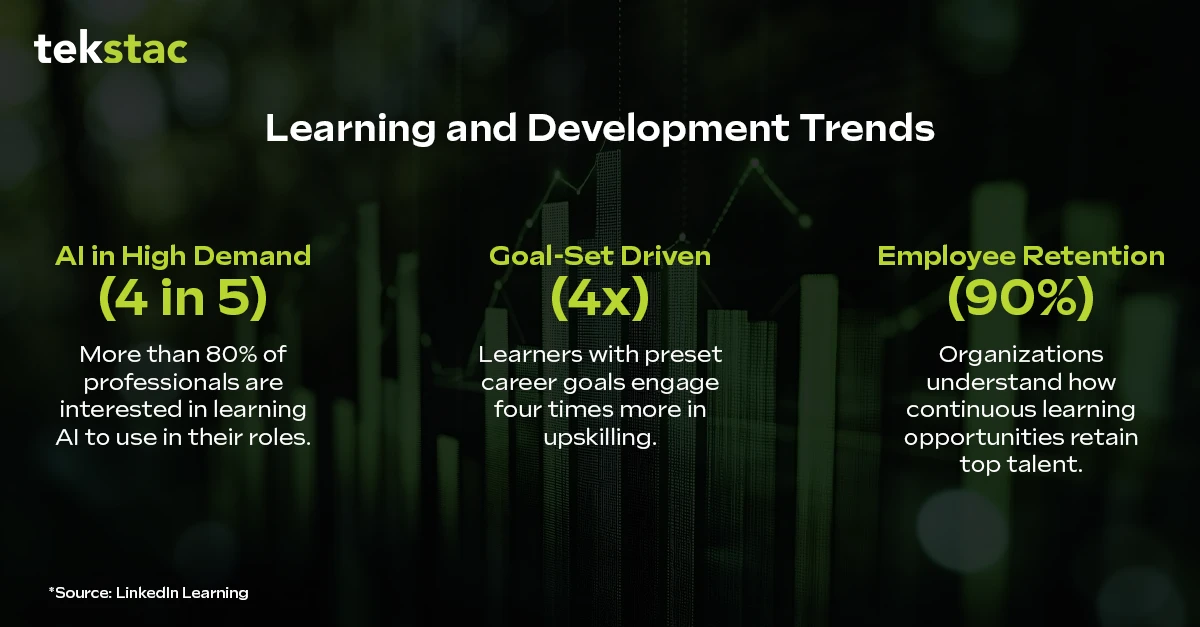
1. AI-Driven Skill Development for Future-Ready Employees
AI or Artificial Intelligence is crucial for skill development. It helps companies to identify gaps and forecast futuristic upskilling requirements.
What we now need in 2026 is Responsible AI adoption. Companies need to design Human+AI approach that enables people to thrive in partnership with AI.
Following this allows IT aspirants to align their knowledge with the current demand for skills and to stay ahead of the bell curve such as artificial intelligence, blockchain, and cloud computing.
2. Hyper-Personalized Upskilling Method
The corporate L&D Program has shifted towards personalized learning where content is customized based on each learner’s skill, responsibility, and goal in career.
In the coming years, companies will focus on specific skills for each person rather than on predefined roles. It leads to greater agility and fills the skill gaps more easily.
3. Microlearning
As professionals are becoming busier, on-demand upskilling has concise. Microlearning is going to dominate L&D strategies in the coming years. It involves bite-sized content to be learned in minutes, which makes it perfect for IT teams who manage tight schedules.
They can learn quickly and apply at any time level of experience. They are perfect for mobile learning and reinforce knowledge through repetition. Tekstac supports microlearning, allowing learners to get access to training modules anywhere, anytime.
4. Immersive Learning
2026, like this year, will equally advocate continuous learning culture with the power of immersive learning technologies. AR or Augmented Reality and VR or Virtual Reality will reign supreme in 2026 also.
With this, IT professionals can engage in the simulated environment to practice troubleshooting systems and coding and handling any complex projects without the risk of the real world.
5. Data-Driven Learning
With the great pressure of the ROI of training programs, the Learning and Development trends in 2026 have been data-driven. Data analytics is the core of any training these days to optimize and customize training programs based on performance metrics, skill gaps, and learning experiences.
For instance, at Tekstac, trainers collect and analyze information from different sources like learning management systems, performance assessments, and feedback surveys, to learn the areas of improvement. Later the insight is used to customize training content, and progress tracking, and to adjust strategies for real-time upskilling.
6. Gamification
The future of corporate learning mostly relies on engagement metrics. The more engaging the training, the better results. Gamification is more than a buzzword. It’s a powerful tool for engaging employees, driving motivation, and fostering collaboration within teams. Gamified learning in 2026 will include AI, VR and AR in the learning environments, setting new benchmarks in immersive learning experiences.
Hybrid and remote working are the future, and it becomes necessary to create engaging L&D programs for remote teams through gamified eLearning. And who doesn’t enjoy a dynamic, game-based learning experience with a bit of healthy competition?
7. Social Learning Platforms
Social learning methodologies are transforming employee training and development in miraculous ways. Platforms like LinkedIn and internal social platforms within organizations are taking precedence for knowledge sharing and group discussions.
Not only that, incorporating interactive forums within LMS tools helps employees engage in real-time and share insights.
Summary of Learning and Development trends
In a nutshell, the main Learning & Development trends in 2026 will continue to be around AI, employee engagement and continuous learning.
Collaborate with solutions like Tekstac to harness the power of cutting-edge learning platforms and drive success. Because the future of work is in evolving and educating peers for company’s collective growth.
Learn better to work better!
FAQs on L&D Trends
1. Why is continuous learning important in 2026?
Continuous learning helps IT professionals to upskill with the latest technologies and perform well. Upskilling makes them more productive and gives job satisfaction in the long term.
2. What is involved in Learning and Development programs?
AI-driven upskilling, hyper-personalized learning paths, microlearning, and data-driven learning strategies.
3. How do companies implement effective L&D programs?
Companies can hire an L&D platform like Tekstac for workforce upskilling needs, where it provides skill-based continuous training to the talents by equipping them with the right tools and knowledge.
4. Why is AI important in corporate learning and development?
AI helps organizations identify skill gaps, personalize learning paths, and predict future upskilling needs. It enhances learning efficiency and supports real-time progress tracking.
Cognitive Overload Challenge: Why Tekstac Wins Where Traditional LMS Fail
It’s no surprise that technology is advancing faster than ever before.
Every day, teams learn new tools, programming languages, cloud platforms, and frameworks to keep up. The pressure to continuously upskill, reskill, and adapt is very high.
Despite all the learning platforms, content libraries, and online courses available, many organizations struggle with cognitive overload. It actively harms motivation, engagement, and retention.
Most platforms keep adding more and more videos, content, and courses, forgetting that the human brain does not thrive on abundance, but instead on clarity.
And this is where Tekstac does things differently. But before that, let’s explore what cognitive overload means.
What Exactly Is Cognitive Overload?
Cognitive overload happens when the brain is overwhelmed with more information than it can reasonably process. Rather than laziness or a lack of willpower, it’s more about bandwidth, which can be stretched thin.
For example, imagine a learner who’s working with legacy systems, upskilling in cloud tech, preparing for certifications, and still trying to deliver on business goals. If we add to this a cluttered LMS interface with hundreds of unstructured modules on top, it becomes cognitive overload.
This results in burnout, drop-offs, minimal knowledge retention, and frustrated teams. This is the real cost of cognitive overload, and it’s the cost most traditional LMS platforms ignore.
Why LMS Platforms Contribute to Cognitive Overload
Learning Management Systems came into prominence as a way to organize and distribute training content. However, most of these systems were built decades ago for compliance training, not rapid tech skill development.
Below are the reasons why traditional LMS platforms fall short when it comes to employee training and development, causing cognitive overload:
1) Content dumping without context
Many LMSs typically offer learners a massive library of courses, videos, documents, and quizzes. The problem here is that there’s little guidance on what to choose or why. This is similar to walking into a gigantic bookstore without any recommendations, maps, or curated sections. Similarly, employees feel lost, overwhelmed, and eventually walk away. This is because they see hundreds of modules, many irrelevant to their job or skill level, and realize that there’s no actual career path forward.
2) Lack of role-based personalization
In any organization, no two tech roles are the same. A data scientist has very different learning needs than a systems administrator. Yet, LMS platforms treat everyone like they are learning the same thing, thereby wasting valuable time and also adding to the mental burden of sorting through what is useful and what is not.
3) Reliance on passive learning formats
As mentioned, most LMS content consists of videos, slide decks, and PDFs. Passive learning demands a lot of mental effort without much interaction, which is tough to maintain, especially when working on day-to-day responsibilities. Without proper opportunities to practice the skills learned, learners will not be able to retain the knowledge or apply it confidently.
4) No meaningful feedback and assessments
Some platforms either lack meaningful assessments or rely on generic, manually graded quizzes that do not provide timely that do not always provide actionable feedback. When learners fail to understand where they stand or what to focus on next. This cognitive overload drains motivation and makes the learning experience confusing.
5) No adequate access to mentors and coaches
When challenges arise, especially in complex tech learning, learners may be left to figure out on their own. This is because traditional learning platforms leave learners with little to no access to mentors, coaches, or communities. This can amplify cognitive overload and the risk of burnout as well.
6) Siloed learning activity
Most importantly, many LMS platforms disconnect learning from real business goals or project demands. Learners may complete courses merely because they were assigned, feeling it as an obligation rather than a pathway to growth.
Ultimately, all the above factors combine to create an environment that causes cognitive overload.
How Tekstac Addresses Cognitive Overload Differently
While most platforms aim to treat the symptoms of cognitive overload via shorter videos, better UI, and nudges to take breaks, Tekstac tackles the root causes by rethinking how content is delivered, practiced, assessed, and supported.
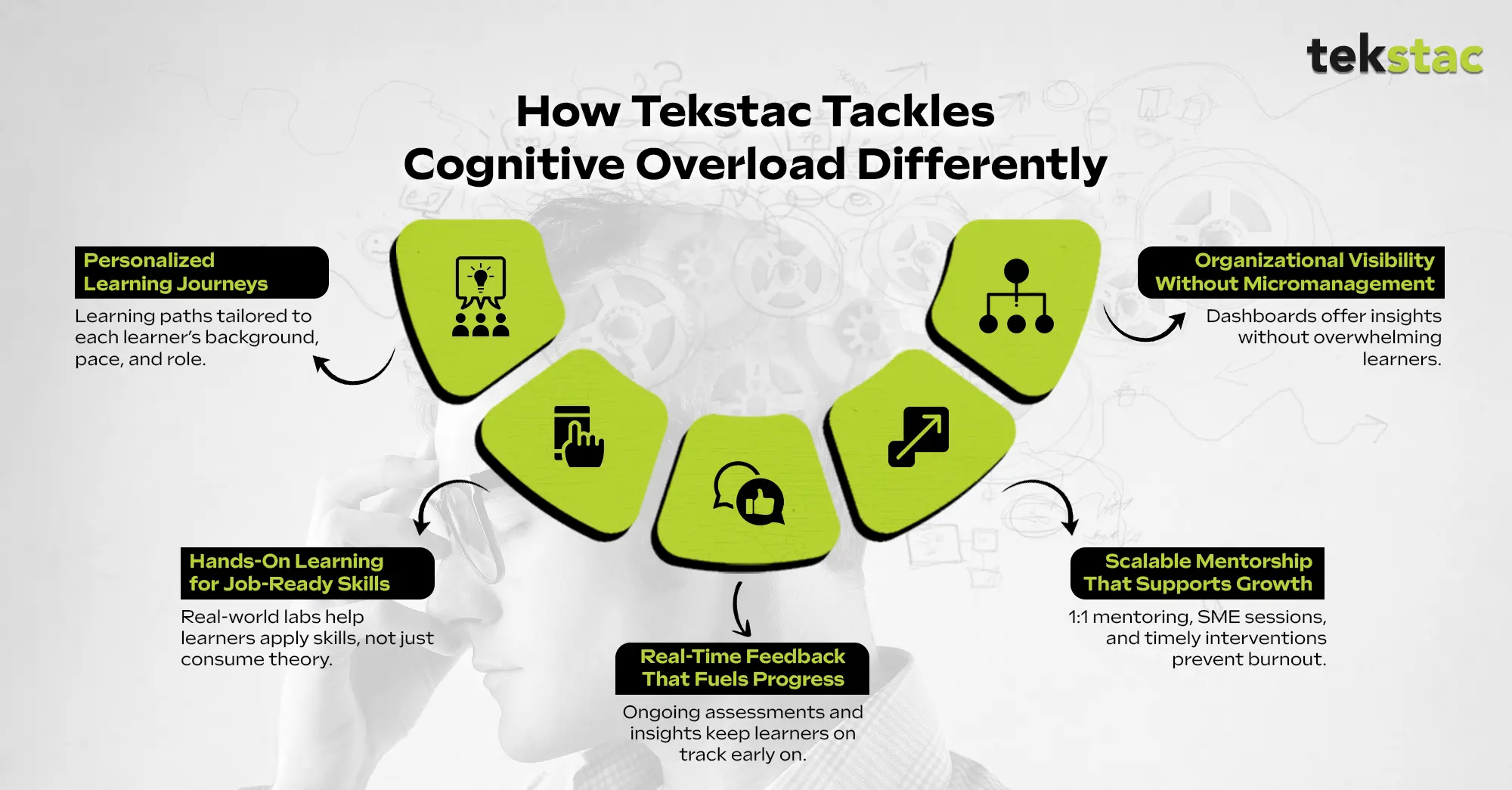
1. Built-in Learning Intelligence That Personalizes the Journey
Cognitive overload arises when every learner is forced down the same path, regardless of background, goals, or pace. Tekstac helps flip that through:
Custom learning paths: Be it a college student being prepared for onboarding or a full-stack developer upskilling for an upcoming project, with Tekstac, organizations can personalize learning tracks with only the relevant content.
AI-powered recommendations: Tekstac adapts the learner journey depending on performance and feedback, thereby suggesting remedial content, skipping what the employee already knows, and encouraging where support is needed.
Pre-onboarding to project readiness: Learning is not dumped on users in one go, but rather it’s sequenced smartly from foundational to advanced with ample opportunities to show application along the way.
Result: Learners will no longer drown in irrelevant content. Each user is shown what they need, when they need it.
2. Practice-first Model That Reduces Theoretical Fatigue
Reading documentation or watching lectures can only go so far. The real overload kicks in when learners cannot seem to connect theory to application.
Immersive hands-on labs: Tekstac’s lab environment mirrors real-world systems, right from databases to cloud infrastructure. Hence, learners learn by doing.
Lab-as-a-service: No external setup is needed. Learners need to just log in, practice, and build muscle memory.
Project-specific training: Organizations can deploy labs aligned to their tech stack, thereby making sure it is relevant and application-ready from day one.
Result: This way, learning is anchored in action. This improves retention and reduces cognitive overload or fatigue caused by passive intake.
3. Built-in Feedback Loops to Prevent Overload Creep
We might observe that some learning platforms assess only at the end, leading to binge-learning followed by failures. Here’s how Tekstac helps overcome this:
Auto-evaluated assessments along the way: Each module ends with quizzes or code checks that immediately allow learners to understand where they fell short.
Video and scenario-based assessments: Real-world judgment is tested instead of just memory recall.
Plagiarism checks and reliability index: Removes blind spots in assessment credibility. This enables more honest learning loops.
Result: Learners stay calibrated throughout instead of discovering gaps too late in the learning journey.
4. Mentorship and Intervention That Humanize the Experience
One of the biggest causes of cognitive overload is the feeling of being stuck and not supported. Tekstac handles this with scalable human touchpoints.
Mentor marketplace and 1:1 connects: Learners can engage with experts directly to resolve any blockers.
SME sessions and hackathons: Keeps motivation high and concepts applied.
Automated/manual learning interventions: Based on learner data, facilitators can step in when progress slows down and before employee frustration sets in.
Result: This way, learners never feel isolated. The system anticipates where support is required before burnout occurs.
5. Organizational Oversight Without Micromanagement
Leaders drown learners in content, hoping something will stick. Tekstac enables smarter program management.
Skill inventory visibility: Know who is learning what, and how they’re progressing, at any time.
Custom dashboards and predictive analytics: Spot high performers, identify gaps, and align training to project demand.
Audit trails and accountability: All activity is logged, but not surveilled. This helps build trust without compromising on standards.
Result: Learning is made more accountable.
What Cognitive-Ease Learning Looks Like in Action: Real-World Scenarios with Tekstac
Theory can only go so far. To really understand how cognitive-friendly learning transforms skill development, let’s walk through real-world use cases where Tekstac shapes how talent upskills.
Scenario 1: Onboarding 200 Fresh Graduates in Emerging Tech
Let’s say an IT consulting & services company need to onboard and skill 200 freshers on Python, cloud computing, and containerization in just 6 weeks. Traditional LMS-based training with heavy video lectures, PDFs, and scattered lab access had failed. Learner dropouts were high. Completion didn’t translate to readiness.
How Tekstac helped:
- Mapped 6-week outcomes into progressive learning paths, with daily 60-minute capsules (including theory, practice, and assessment).
- Each module was goal-oriented, focusing on job-critical outcomes.
- Cognitive fatigue was reduced through clear structure, active recall via quizzes, and peer discussion spaces.
- Mentor escalations dropped by 40%, and 96% of learners were project-deployment-ready by Week 7.
Cognitive outcome: Learners were focused, confident, and retained more because they were never overloaded to begin with.
Scenario 2: Upskilling Experienced Developers on New Stack Without Hurting Productivity
A tech product company wanted to reskill 50 backend developers on a new microservices architecture while they continued working full-time. Long training hours or forced weekend bootcamps had led to resistance before.
Tekstac helped in the following ways:
- Learning was broken into 30-minute micro-paths that fit into existing workdays.
- Labs were cloud-based, so developers didn’t have to waste time setting up environments.
- Weekly performance snapshots gave team leads visibility into progress without pressuring learners.
Cognitive outcome: This led to zero dropouts, and developers applied what they learned directly to upcoming product modules.
Final Word: Reduce Cognitive Overload, Accelerate Readiness
Cognitive overload, when unaddressed, can be the blocker behind most failing learning programs. It can show up in low completion rates, poor retention, and that frustrating gap between training and real-world application. Most companies may not even realize that it’s happening.
Here, the solution is a better design rather than more content. Learning must be structured around how the human brain works, meaning that it must be layered, contextual, and purposeful. Tekstac addresses these challenges by curating learning paths, delivering hands-on practice and feedback, and so on, thereby ensuring that learners walk away with job-ready skills.
Organizations that are looking to create a workforce that learns faster, retains more, and applies with impact it’s effective to start by fixing the learning experience itself.
Top 10 Goal-Setting Strategies That Solve Workplace Challenges in L&D
Sarah from marketing completed 12 training modules last quarter. However, she still struggles with the same workplace challenges she faced six months ago.
This happens everywhere. Employees complete training, yet nothing changes in their daily work. They finish courses on time management, but still miss deadlines. They take leadership workshops but avoid difficult conversations. They learn presentation skills but freeze up during client meetings.
Workplace challenges persist. Teams still struggle with communication breakdowns. Managers still micromanage instead of delegating effectively. Projects still fail due to poor planning and execution. The skills people need to succeed at work remain underdeveloped, despite all the training investment. Why?
Why Workplace Challenges Persist Despite L&D Efforts
Remember the last time employees sat through mandatory training? That glazed-over feeling when the instructor asked if there were any questions and the room went dead silent?
One of the main workplace challenges in L&D is not that employees are resistant to growth, but that most companies do not yet treat skills like abilities that need practice. Here are a few reasons why workplace challenges persist despite employee development efforts:
1. Learning is not treated like a process: Most companies offer workshops or courses and consider the job done. But skills take repetition and real-world practice to develop, not just a single chunky session or video. Innovative strategies like microlearning can address these issues.
2. Learning content doesn’t address specific job problems: Employees often face specific challenges, like handling conflict, managing deadlines, or delegating tasks. But the training they receive is too generic and doesn’t help solve those real issues.
3. There are no clear goals tied to learning: Employees complete training, but they do not understand what’s expected to change in their work afterward. Hence, without specific goals, it’s hard to apply what was learned.
4. Managers don’t support ongoing development: After training, most employees are left on their own. If managers don’t follow up or create space to apply new skills, the learning may be quickly forgotten.
5. L&D is not a long-term plan: Learning programs are often launched only after problems show up. There’s no proactive strategy to build skills ahead of time — which means the same challenges keep repeating.
How Goal Setting Drives Employee Development Amid Workplace Challenges
While most organizations focus heavily on delivering learning, very few take the next step to define what employee development should look like in practice. Without clear outcomes tied to learning, employees walk away from training unsure of what’s expected to change. Furthermore, when managers fail to reinforce those expectations, even well-designed programs can lose their value and impact.
Goal setting helps fix these workplace challenges, bringing structure and accountability into the development process. For example, a leadership goal might be:
- “Hold two one-on-one check-ins with each team member every month”
- “Delegate one full project each quarter without daily intervention”
These become signals of whether someone is actually developing the skill. With goals like these, employees can track progress, apply what they learn, and get targeted feedback from their managers. Some other major reasons why goal-setting helps:
1. It turns learning into action: Goal-setting strategies in L&D bridge the gap between knowing and doing, giving employees a clear target to apply what they have learned in real work situations.
2. It adds structure to development: Without goals, employee development can feel incomplete. Employees need specific, time-bound outcomes that guide their growth step by step.
3. It makes progress visible: Learning without visible milestones can make employees feel stuck. Goals give employees and managers a clear way to track movement in regard to skill change.
4. It personalizes the learning journey: Setting individual developmental goals helps employees focus on what they need, along with what the company rolls out.
5. It creates accountability and momentum: When goals are clear, ownership becomes easier. Employees stay engaged while managers know how to support them, review progress, and celebrate development wins.
10 Goal-Setting Strategies That Work in L&D Workplace Challenges
Most companies use SMART goals or OKRs during performance reviews. These work fine for tracking quarterly targets or project milestones. But they fall short when applied to skill development.
Traditional goal frameworks ignore this messiness. They assume you can learn delegation skills the same way you’d complete a sales quota – with clear milestones and predictable timelines. But developing capabilities means breaking old patterns, which takes time and repeated practice. Real skill development looks different. Someone learning to give feedback might nail it with friendly colleagues but struggle with difficult personalities. Someone building presentation skills might excel at internal meetings but panic during client calls. These aren’t failures – they’re normal parts of learning and workplace challenges that goal-setting must account for.

The strategies below recognize this reality. They work with the natural ups and downs of skill development instead of fighting against them.
1. Translate learning objectives into behavior-based goals
One of the biggest gaps in L&D is assuming learning equals doing. High performing organizations take it further and define success as an observable behavior. For example, an objective like “complete negotiation training” can look like “negotiate three client contracts without senior support” as an outcome. This changes the focus from input (the training) to output (the behavior change). To implement this, organizations must align every learning intervention with a concrete, on-the-job action they expect to see post-training, and review it in one-on-ones. Strategies like gamification can change how organizations build skills for practical outcomes.
2. Use performance thresholds to tackle workplace challenges
Most goals are set around finishing something, be it attending sessions or completing a module. These don’t always translate to real-world application, especially when workplace challenges come into play. Top L&D leaders set thresholds, minimum performance standards that indicate readiness. For instance, a presentation skills program might require the employee to lead two internal briefings rated at least 4 out of 5 by peers. This measures if an employee performed at an acceptable level, and this works best when you link learning goals to clear evaluation rubrics or feedback criteria.
3. Anchor goals to business inflection points
Instead of setting goals in isolation, tie them to upcoming business shifts, be it a new product launch, market expansion, or process change. This makes learning feels urgent, relevant, and visible too, helping stakeholders buy in as the goal supports actual business movement.
4. Integrate reflection as a goal
One underrated strategy is making self-assessment part of the goal. This promotes self-awareness and helps employees internalize learning before rushing into execution. Organizations can implement this via reflection logs, post-training prompts, or weekly development check-ins.
5. Design learning sprints that reflect workplace challenges
Borrowed from agile methodology, this involves setting short, focused development goals over 2-4 week sprints, with check-ins baked in. The key is the midpoint checkpoint to provide course correction. Sprint-based goals create urgency without overwhelming employees, while allowing for real-time coaching. These sprints employ strategies that help bridge the gap between classroom training and real-world workplace challenges with workplace training, ensuring skills improve through practical application.
6. Include “unlearning” in the goal
Leaders stress that development is not merely about acquiring skills, it’s also about unlearning ineffective habits. If someone’s been micromanaging for years, a good goal must allow them to delegate with only one follow-up per week and allow autonomous decisions. For this to work, goals should explicitly call out what needs to stop.
7. Build layered goals for deep skill growth
Rather than isolate a skill in one goal, layer goals across exposure, practice, and mastery. Each layer deepens the skill and reinforces it through repetition. To apply this, structure L&D goals into progressive levels that build on one another over time, similar to scaffolding in instructional design. Organizations with such skills-based strategies are 57% more likely to adapt quickly to change. This helps stay competitive while employees also build skills that are future-ready.
8. Pair goals with peer accountability
Peer support builds consistently. One method is to pair employees with a peer in a similar development track and set shared review goals. This builds community and creates informal coaching loops. Use buddy systems or learning cohorts to scale this. As per LinkedIn, 94% of employees would stay longer at a company that invests in their career development, and peer accountability supports this by creating shared growth and motivation.
9. Reverse engineer goals from business impact metrics
Instead of asking, “What should they learn?” ask, “What impact do we want to see?” Then set development goals that target those inputs. This approach ensures that learning is directly linked to measurable outcomes rather than assumptions. When goals become skill-based, companies are 63% more likely to achieve results, thereby creating a direct link between employee development and workplace challenges.
10. Treat development goals as experiments
Growth is rarely linear, and we must acknowledge this by framing goals as hypotheses rather than certainties. For example: “Test running team check-ins without a formal agenda to increase engagement over one month.” This lowers the fear of failure and encourages employees to try new behaviors, assess the results, and refine. Implementing this requires managers to be coached on setting short-term experimental goals to debrief outcomes without judgment.
Make Goal Setting the Heart of Employee Development
Effective employee development is uncomfortable and requires commitment from everyone involved, but it’s also the only approach that actually works. Here, the right platform makes all the difference. Organizations that successfully implement these goal-setting strategies for L&D workplace challenges, they need systems that support focused, measurable development. Platforms like Tekstac bridge this gap by combining structured learning paths with hands-on practice environments and real-time progress tracking.
When employees can practice skills in immersive labs, receive AI-powered assessments that identify specific improvement areas, and follow customized learning journeys aligning with their career development plan, goal setting turns into measurable progress. Additionally, comprehensive dashboards and analytics help managers track whether the goal is actually translating into improve stakeholder relationships and business outcomes.
Over 1 million+ professionals have already experienced this focused approach to development, with organizations reporting 100% retention rate when learning is tied to clear, achievable goals. Your employees too are waiting for you to give them a real path forward, one that’s measurable, practical, and directly connected to their daily work. Explore Tekstac today!
Hands-On Labs vs Traditional Training: Which Builds Real Skills Faster?
The learning and development world often finds itself at a crossroads — Hands-On Labs vs Traditional Training.
Organizations pour resources into training programs in efforts to see their teams learn new skills quickly and effectively. A lot of traditional training just doesn’t stick. People often get the theory but struggle when it’s time to actually do the job. That gap slows things down, drains money, and holds teams back.
So what works better? Should you go for hands-on labs where people learn by doing? Or stick with classroom sessions and online courses? The answer can change everything from budget allocation to employee confidence in their skills.
What Are Hands‑On Labs vs. Traditional Training?
Hands-on labs allow employees to practice skills in a simulated or real world environment. Picture this—someone in cybersecurity working through real network attacks in a safe virtual setup. Or a med student practicing on high-tech simulation gear before ever touching a real patient. These labs might be physical, fully online, or a mix of both.
Now compare that to traditional training. It’s more about lectures, slides, and guided lessons. Everything’s laid out in a set format, usually in a classroom or through online courses. This approach prioritizes understanding concepts before moving to application.
How Do We Measure “Real Skills Faster”?
To measure real skills faster, we look at metrics such as:
- Time-to-competency
- Proficiency over time
- Retention with application
Measuring speed in skill development requires looking at how fast learners reach actual job competency, i.e., the point where they can perform tasks independently without constant guidance or review.
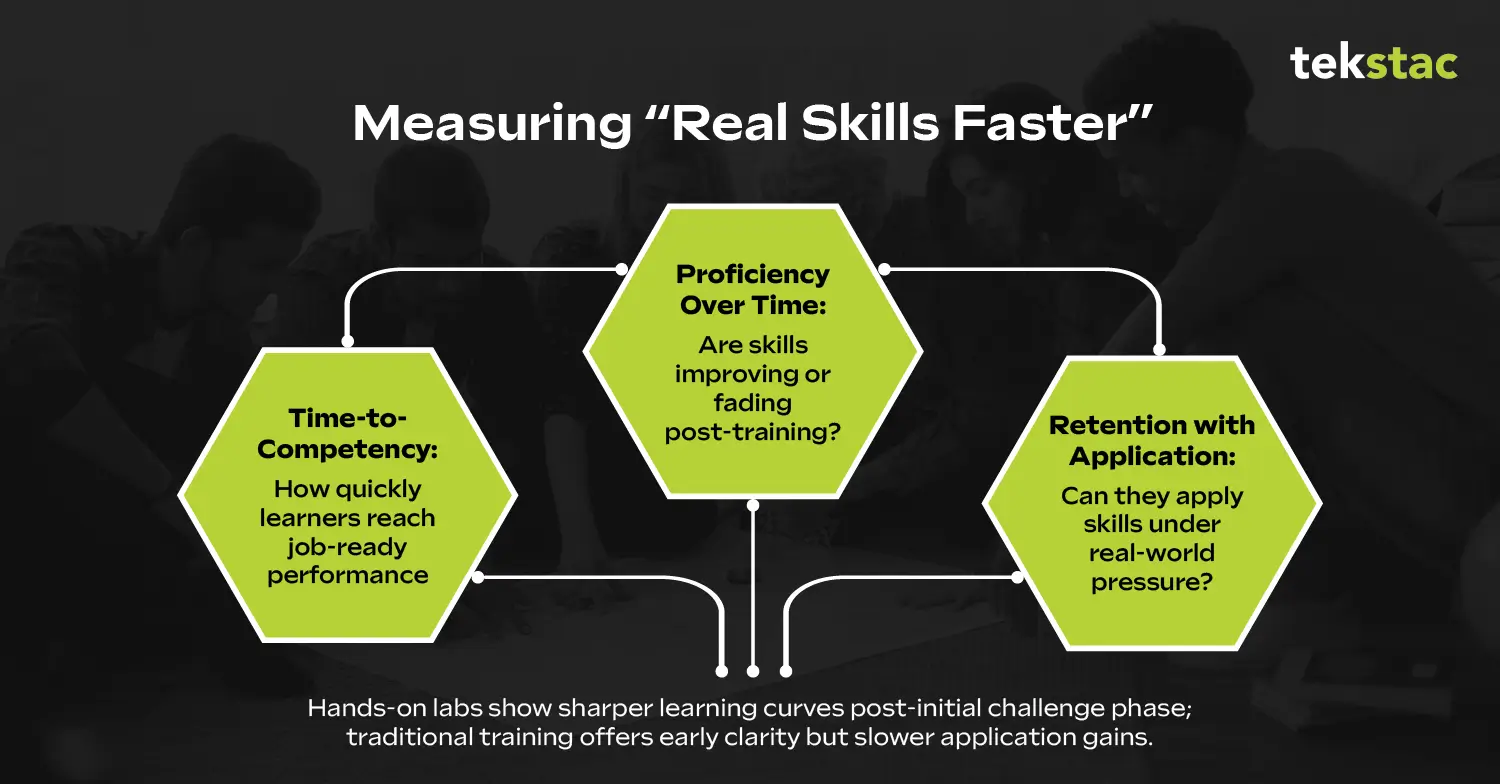
1. Time-to-competency: This tracks the period from initial exposure to independent performance. This metric matters especially in hands-on labs training method because it shows real business impact. Some learners might finish traditional courses quickly but can still struggle when faced with actual work situations.
2. Proficiency over time: This metric checks how skills evolve after initial training, whether learners are continuing to improve. More importantly, it helps understand if employees retained and built on what they learned, or if skills deteriorated without reinforcement.
3. Retention with application: This metric helps measure if skills are translating successfully into real-world scenarios. It assesses whether learners can successfully apply learned skills weeks or months later when the pressure is on. It’s one of the core metrics of training methods such as hands-on labs or immersive labs.
Studies show hands-on training and traditional learning don’t follow the same curve. People in labs might hit a rough patch early on. It feels harder at first. But once they get it, things move fast.
On the other hand, traditional training methods typically produce smoother, more predictable curves early on. Learners build knowledge, and assessment results look more consistent in the short term. However, the real test comes during transition to actual application, where learners face a secondary learning curve as they adapt to practical situations.
Evidence: Which One Builds Skills Faster?
Below, let’s examine in detail which training method helps build and apply skills faster, whether it’s hands-on labs, traditional training, or both.
1) Hands-On Labs: Strengths and Limitations
Hands-on labs can require higher investment amounts due to purchase of equipment, software, and specialized instruction. But they may reduce the time employees spend transitioning from training to productive work.
Hands-on training creates conditions that naturally accelerate skill development. When learners face challenges in simulated environments, they must solve them immediately. This can create a pressure-cooker effect where learning happens under conditions that mirror real business situations.
Hence, the feedback loop in hands-on environments operates at a higher speed. Quick feedback makes a big difference. People catch mistakes early and learn what works by actually doing it. In hands-on setups, they’re more likely to try stuff, mess up, and figure things out. That kind of trial-and-error helps build real problem-solving skills, not just for the task at hand, but for situations they haven’t even seen yet. More than anything, it gives them the confidence to handle the unknown.
2) Traditional Training: Strengths and Limitations
Traditional training is best at building systematic understanding efficiently. Difficult topics can be broken down logically, with each concept building on previous ones. This helps develop comprehensive mental models before employees start practicing application.
Traditional training usually moves slow and steady, unlike hands-on labs. The instructor can stop and explain things before jumping ahead. That helps people who might need more time. With hands-on stuff, it’s easy to feel lost early on, especially when things get too complex too fast.
However, in contrast to hands-on labs, traditional approaches struggle with the transfer problem. Knowledge gained does not always translate smoothly to real-world application. Learners may understand concepts but hesitate when faced with actual decisions or problem-solving situations.
This nature can create artificial delays, where learners might be ready to tackle practical applications before the curriculum allows them to, leading to frustration and missed opportunities for reinforcement through practice.
3) Hybrid or Blended Approaches
Smart organizations increasingly recognize that the hands-on labs versus traditional debate does not always create the right choice for every organization. For some companies, the most effective training approach can be a combination of both, using each method’s strengths to address the other’s limitations.
Sometimes training mixes both. First, you learn the basics in a class. Then you do hands-on work to practice. Or you try things out first, ask questions, and then get the lessons to make sense of it all.
Here, the key is in timing and integration. Rather than treating these as separate phases, effective blended approaches integrate theory and practice together, allowing learners to move fluidly between understanding concepts and applying them in realistic contexts.
With technology, organizations can perfectly balance theoretical resources while working through practical challenges, or where simulation environments include embedded coaching and explanatory content that appears when needed.
The best training blends both worlds.
Give your team the skills they need now—and the growth path for tomorrow.
See How Tekstac Helps.
Variables That Affect How Fast Employees Learn
Not everyone learns at the same speed. Some pick things up quickly, others take their time. That’s not a bad thing. It usually means the training style doesn’t fit their experience, situation, or sometimes the content itself.
1. Learner Experience Level (Novice vs Advanced)
Experience level dramatically influences which training approach will build skills faster. When you’re new, it helps to learn step by step. Jumping into hands-on work right away can be tough if you don’t know the basics.
That said, beginners can still learn well with hands-on tasks—as long as they’re not too hard. The goal is to build confidence, not show what you don’t know.
If you already have some experience, hands-on usually works best. You can connect new stuff to what you already know and learn faster. They can fill in knowledge gaps independently as they encounter them during practice.
Experienced professionals can find traditional training frustrating because it moves too slowly through concepts they already understand partially. They prefer to jump into application and learn through problem-solving, using theoretical resources as needed to support their practice.
2. Training Context: High-Risk vs Low-Risk Environment
The stakes involved in skill application influence training design. In high-risk places, where mistakes can cause big problems, it’s better to start with careful traditional training before trying hands-on work. In low-risk settings, people can experiment more and learn by making mistakes without causing trouble.
Hence, the risk level also affects the design of hands-on training itself. High-risk skills require carefully controlled simulation environments that can replicate realistic conditions without actual danger, while low-risk skills might be practiced in real situations with minimal modifications.
3. Context Difficulty (Simple Procedural vs Conceptual Strategy)
Simple tasks work well with hands-on learning. When learners can see the results right away—like using software, handling equipment, or following a set process—they pick it up faster.
Skills that need big-picture thinking, analysis, or creativity often do better with traditional training first. Things like understanding markets, reading organizational behavior, or planning strategy need solid mental models that hands-on labs work alone might not build.
After people learn the basics, doing hands-on work helps a lot. Case studies, simulations, or real projects let them try out what they know and get better in ways lectures don’t. Usually, it works best to break skills into steps—first teach the ideas, then practice in hands-on labs, and finally mix both with real experience.
The Path Forward
After understanding both approaches, the evidence points to a clear conclusion that the hands-on labs versus traditional training misses the real opportunity to integrate them intelligently through technology platforms that combine the systematic knowledge-building of traditional training with the immediate application benefits of hands-on labs.
The most effective approach integrates structured learning content with immersive practice environments. These are backed by real-time assessment and personalized guidance. When learners can access resources when they need them while working through realistic scenarios, they develop both understanding and performance.
Modern learning platforms like Tekstac exemplify this integrated approach. They combine extensive sandbox environments for real-world practice. Learners can move fluidly between both as their needs and progress dictate. Tekstac’s intelligent assessment and analytics track actual skill development patterns. Its AI-powered proctoring and plagiarism detection help ensure credibility, while predictive analytics identify skill gaps.
While speed matters, sustainable speed matters more. Hence, integrated learning platforms deliver both immediate impact and long-term capability, creating learning experiences that truly improve performance.
AI in Personalized Learning: Driving Workforce Growth at Scale
Generative AI is no longer a futuristic concept—it’s part of everyday life. A 2025 Deloitte survey revealed that 50% of professionals use generative AI for personal tasks, while 25% already apply it at work.
If employees are this quick to adopt AI in daily life, why should corporate learning lag behind?
AI-powered personalized training meets employees where they are, making learning more intuitive, engaging, and effective. In fact, EY projects AI could boost productivity in India’s IT sector by 45%, underscoring the scale of impact.
Traditional training models—static, one-size-fits-all, and disconnected from real-time skill needs—are no longer enough. Instead, AI in personalized learning enables adaptive pathways, role-specific upskilling, and continuous performance optimization. Organizations that embrace it can develop talent at scale, improve retention, and future-proof their workforce in an AI-driven era.
The Evolution of AI in Personalized Learning for Corporate Training
Historically, corporate learning programs have relied on standardized content delivery, which often fails to engage employees or address specific skill gaps. This generic approach can lead to disengagement and suboptimal performance.
In contrast, AI in personalized learning acknowledges that each employee has unique learning preferences, paces, and professional goals.
Key Benefits of AI in Personalized Learning for Businesses
- Contextualized Learning: AI tailors learning materials based on job role, past performance, and future career trajectory, ensuring that training directly impacts business outcomes.
- Proactive Knowledge Enhancement: Rather than waiting for performance reviews, AI identifies skill deficiencies early, providing targeted microlearning interventions that prevent knowledge gaps.
- Operational Efficiency: By automating administrative tasks such as tracking progress and generating reports, AI reduces the burden on HR and training departments. This efficiency allows for the reallocation of resources towards more strategic initiatives.
- Enhanced Engagement: AI-driven platforms assess individual learning needs through tools like surveys and quizzes, ensuring that content is relevant and engaging. This personalized approach fosters a deeper connection to the material, increasing motivation and participation.
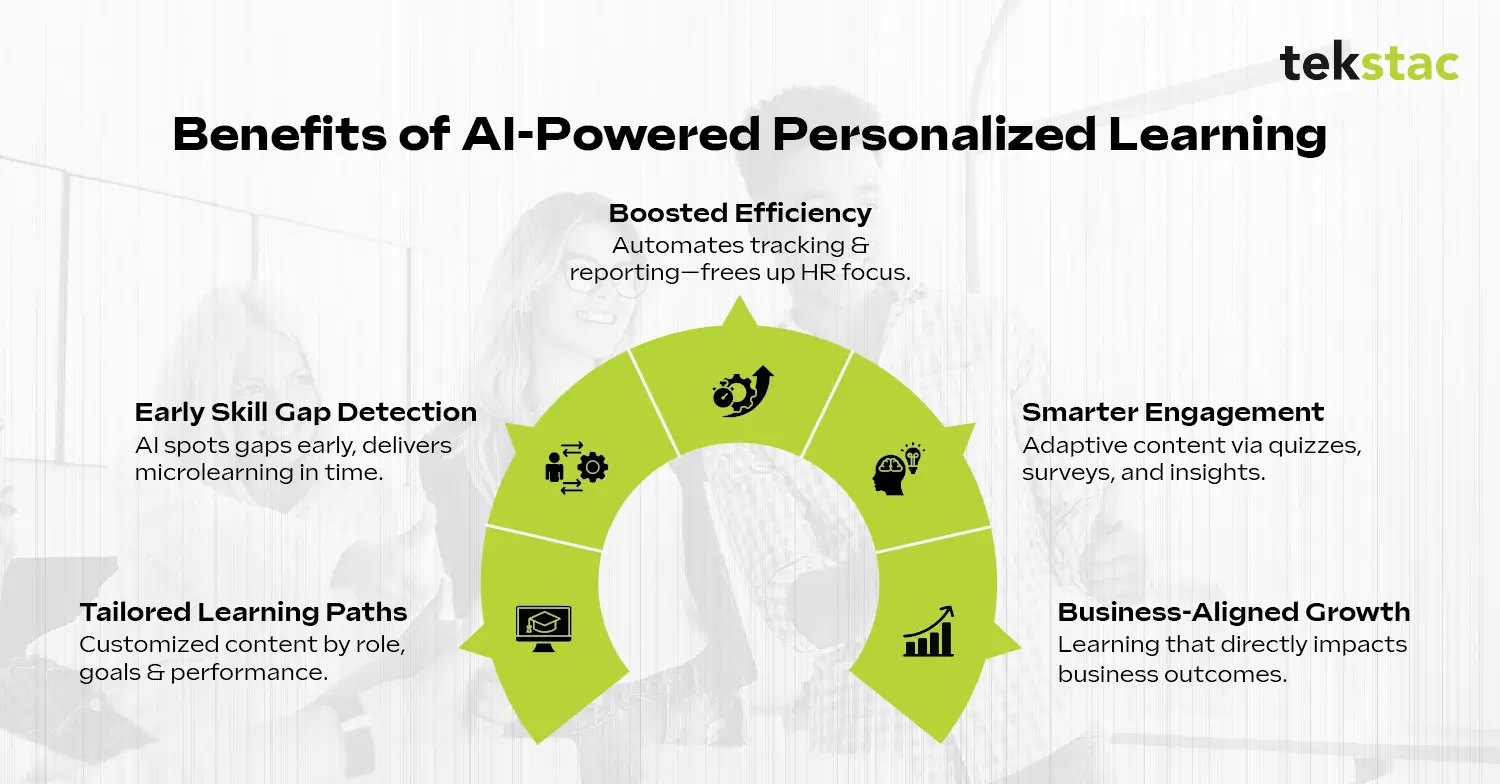
Traditional learning systems rely on fixed content modules, which often fail to resonate with individual learning preferences and skill gaps. However, AI-powered adaptive learning pathways transform training into a continuously evolving, employee-specific experience.
How to Implement AI in Personalized Learning Pathways
The successful integration of AI into corporate training involves several strategic steps:
- Data Collection and Analysis: Gather comprehensive data on employee performance, learning styles, and career goals. This data serves as the foundation for developing personalized learning paths.
- AI Model Development: Utilize advanced algorithms to analyze the collected data, identifying patterns and predicting future learning needs.
- Content Personalization: Develop adaptive learning modules that adjust in real-time to the learner’s progress, ensuring that content remains relevant and challenging.
- Continuous Feedback Mechanisms: Implement systems that provide immediate feedback to learners, allowing for timely adjustments to learning strategies and content.
Generative AI extends beyond just real-time conversations—it automates, personalizes, and refines corporate training programs at scale.
Multimodal Learning: AI-Generated Content Across Multiple Formats
AI-powered multimodal learning is changing the way training happens by making content more engaging and tailored to different learning styles. Instead of just reading a manual, learners can watch AI-generated explainer videos, interact with role-playing simulations, or even train in virtual reality (VR) environments.
This is especially useful in industries like manufacturing, where AI-driven simulations let technicians practice maintenance in a risk-free virtual space—improving retention and reducing real-world mistakes. It’s all about making learning smarter, more interactive, and personalized for each individual.
AI-Powered Workforce Upskilling & Retention Strategies
AI is making workforce upskilling easier by helping employees grow without interrupting their daily work. Instead of traditional training, AI personalizes career development by mapping learning paths to future job roles, so employees are always prepared for what’s next.
It also recommends microlearning modules, allowing employees to learn in small, manageable chunks during their workday.
AI helps HR teams predict internal talent mobility trends, ensuring high-potential employees stay engaged and move into roles that match their skills and career goals. It’s all about smarter upskilling that benefits both employees and businesses.
Real-Time AI Coaching for Soft Skills and Leadership Development
While technical skills are critical, AI in personalized learning is addressing the often-overlooked area of leadership and interpersonal skills in corporate training.
Generative AI is bridging this gap by enabling real-time AI coaching in areas like:
- Public speaking and communication: AI-driven voice analysis tools provide instant feedback on tone, clarity, and confidence.
- Negotiation and conflict resolution: AI-powered simulations present real-world business scenarios, allowing employees to practice decision-making.
- Executive leadership training: AI analyzes behavioral patterns and suggests personalized coaching strategies to develop leadership potential.
AI-Powered Translation for Global Workforce Training
AI is breaking language barriers in global workforce training by making learning accessible to everyone, no matter what language they speak. With AI-powered real-time translation, companies can deliver the same training across different regions without losing clarity or meaning.
AI converts live training sessions into multilingual transcripts, generates real-time subtitles for videos, and even localizes training materials by adapting them culturally and linguistically.
This ensures every employee gets the same high-quality learning experience, boosting inclusivity and knowledge retention across multinational teams.
AI in Crisis Management and Decision-Making Training
AI is transforming crisis training for corporate leaders by creating realistic, high-pressure simulations where they can practice decision-making without real-world risks. It doesn’t just test their responses—it also provides AI-driven feedback, analyzing both their emotional and logical approach to problem-solving.
AI can generate alternative scenarios, helping leaders stay prepared for unexpected challenges. For example, George Mason University uses AI-driven simulations like “Go-Rescue” to train professionals in crisis response, allowing them to practice decision-making in dynamic, real-world scenarios.
This kind of smart, adaptive training ensures that executives build confidence and resilience in handling crises before they happen in real life.
Case Studies in AI-Enhanced Training
Several organizations have successfully implemented AI-powered personalized learning:
- Johnson & Johnson: The company employs “skills inference” to evaluate workforce capabilities, allowing for targeted training interventions.
- DHL: By using AI to match staff skills with open positions, DHL promotes internal hiring and reduces recruitment costs.
- Bank of America: AI simulations are utilized to help employees practice challenging interactions, enhancing their preparedness and confidence.
The Future of AI in Personalized Learning and Workforce Development
As AI technology continues to evolve, its role in corporate training is expected to expand. Future developments may include more sophisticated predictive analytics, greater integration with other HR systems, and the use of virtual reality to create immersive learning experiences. Organizations that embrace these advancements will be better positioned to develop a skilled, adaptable, and engaged workforce.
While the benefits are substantial, organizations must navigate challenges such as data privacy concerns, the need for significant initial investment, and potential resistance to change among employees. Ensuring ethical use of AI and maintaining transparency in how data is utilized are paramount.
What if your team could learn smarter, faster, and in a way that truly fits their roles? Experience AI-driven personalized learning with a free demo today!
FAQs on AI in Personalized Learning
1. How does AI in personalized learning improve corporate training?
AI tailors training to each employee’s role, skills, and pace—making learning more engaging, relevant, and effective than one-size-fits-all methods.
2. What are examples of AI-powered personalized learning?
Examples include adaptive learning pathways, AI-driven coaching, microlearning modules, real-time feedback systems, and AI simulations for leadership, crisis, and technical training.
3. Why is AI in learning important for workforce development?
AI enables scalable, role-specific upskilling and continuous performance optimization—helping companies future-proof talent and retain employees in fast-changing industries.
4. Can AI replace traditional corporate training programs?
Not entirely. Instead, AI complements training by personalizing content, automating progress tracking, and enabling real-time coaching—making programs more effective and efficient.





